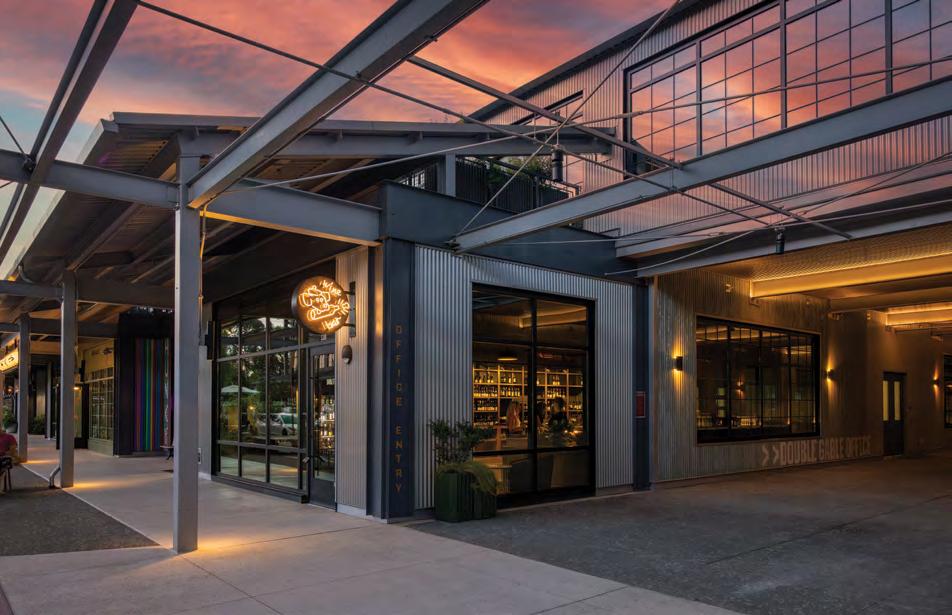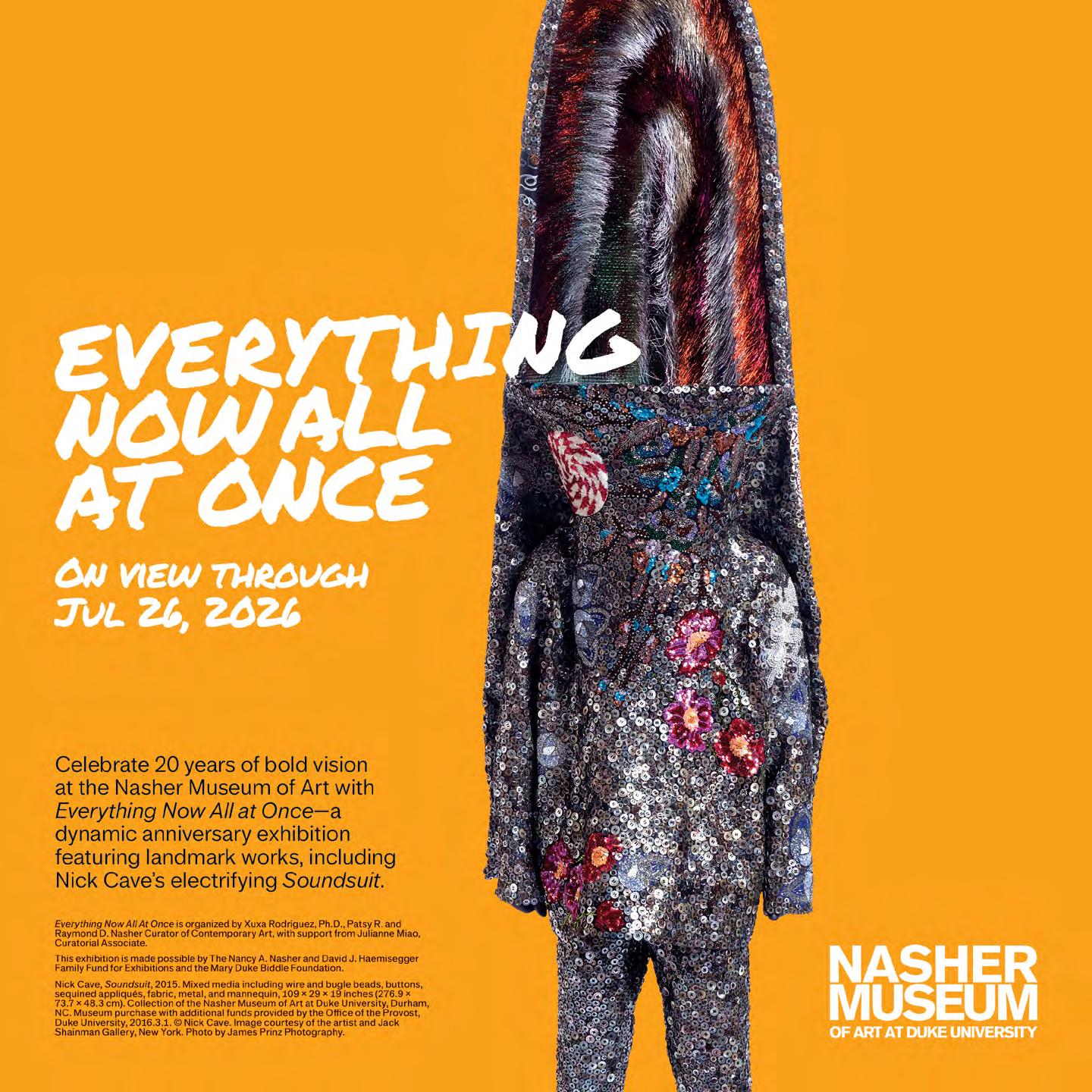
Raleigh | Durham | Chapel Hill October 1, 2025
















Raleigh | Durham | Chapel Hill October 1, 2025


























By Justin Laidlaw, p. 21



















Interdisciplinary artist John Felix Arnold III spent his childhood in Durham. His new exhibit draws on artifacts from its history to remind viewers of their connections with the past and the environment.

8
11 How the LGBTQ Center of Durham is navigating federal funding cuts and executive orders aimed at queer communities and diversity. BY JUSTIN LAIDLAW
FOOD & BEVERAGE

21 Talking with multi-media artist John Felix Arnold III about Descartes, Mary Duke Biddle’s wallpaper, and his new show at 21c. BY JUSTIN LAIDLAW
25 A Raleigh couple's decadent millionaire shortbread cookies, known as Artie Bars, have garnered national praise and a local following. BY RACHEL SIMON
27 St. Pierre Wine Shop and Bar in Raleigh’s Iron Works aims to turn unfamiliar varieties into new favorites BY ELLIOTT HARRELL
28 At Big Ed's in Garner, traditional Southern fare comes without embellishment. BY LENA GELLER
30 Films coming to the Triangle this month, including horror films in time for Halloween and some alternatives. BY GLENN MCDONALD
Backtalk 6 Op-ed
Cover
"Sermons in the Soil", 2025 (detail) by John Felix Arnold III PHOTO BY SALLY VAN GORDER
CORRECTIONS In our story titled "Memory Palaces" from the September 17 print edition, we incorrectly identified the name of the Chinese Artists and Organizers (CAO) Collective as the Chinese Artists and Organizers (CAO) Coalition, misidentified the locations of two of the artists—Laura Dudu is based in Oakland, CA, not Durham, and huiyin zhou is based in Durham, not Los Angeles—and mispelled Deborah Willis’s name as Debora.

Andrea Richards, Barry Yeoman Copy Editor
Iza Wojciechowska Editorial Interns Eva Flowe Creative
Creative Director Nicole Pajor Moore
Hurld Director of
Mathias Marchington
Chelsey Koch
Account Representative
Jessica Schell
Durham County Board of Elections
Tuesday, November 4, 2025
The 2025 Municipal General Election for the City of Durham, Town of Chapel Hill, Town of Morrisville, and Town of Cary, will occur in Durham County, NC on Tuesday November 4th. All precincts, excluding Precinct 26, will be open from 6:30 am until 7:30 pm. Precinct 26 –Rougemont will not be open because no city/town area lies within the precinct boundaries. The following contests will be on the General Election Ballot:*
• City of Durham Mayor
• Town of Cary Town Council District A
• City of Durham City Council - Ward 1-3
• Town of Morrisville Mayor
• Town of Chapel Hill Mayor
• Town of Morrisville Town Council Districts 2 and 4
• Town of Chapel Hill Town Council
• Town of Morrisville Town Council At-Large
• Town of Cary Town Council At-Large
* All registered voters living within the respective municipality and applicable district will be permitted to vote.
Absentee By-Mail: Absentee by-mail voting begins on October 3, 2025. Absentee by-mail ballots can be requested fully online at the following link: https://votebymail.ncsbe.gov/app/home. Be sure to request your absentee by-mail ballot no later than October 21, 2025, at 5:00 p.m. All absentee by-mail ballots must be returned to the Board of Elections no later than 7:30 p.m. on Election Day.
Election Day: All active polling places in Durham County will be open on November 4, 2025, from 6:30 a.m. – 7:30 p.m. To find your Election Day polling place, please use the State Board of Elections Polling Place Lookup Tool at the following link: https://www.dcovotes.com/voters/voting/polling-locations
Early Voting: Early voting in Durham County will occur from Thursday, October 16, 2025 –Saturday, November 1, 2025. Hours are consistent at all five early voting sites and are as follows:
• Weekdays: 8:30 a.m. – 6:00 p.m.
• Saturdays (Oct.18th and 25th): 8:30 a.m. – 1:00 p.m.
• Saturday (Nov.1st): 8:00 a.m. – 3:00 p.m.
• Sundays (Oct.19th and 26th): 12:00 p.m. – 4:00 p.m.
S. Alston Ave.,
Voter Registration Deadline: The voter registration deadline for the 2025 Municipal General Election is Friday, October 10, 2025 (25 days prior). Voters that miss the registration deadline may register and vote during the Early Voting period. Voters who are currently registered need not re-register. Registered voters who have moved or changed other information since the last election should notify the Board of Elections of that change by October 10th. Party changes are not permitted after the voter registration deadline. For more information, visit our website at https://www.dcovotes.com/voters/registration.
Same Day Registration: Voters are allowed to register and vote during early voting. It is quicker and easier to register in advance, but if you have not registered you can do so during Early Voting with proper identification. This same day registration is not allowed at polling places on Election Day. For more details on the requirements associated with Same-Day Registration during Early Voting, visit our website at https://www.dcovotes.com/voters/voting/early-voting
Information regarding registration, polling locations, absentee voting, and other election matters may be obtained by contacting the Board of Elections.
Website: www.dcovotes.com
Phone: 919-560-0700
Email: elections@dconc.gov
Fax: 919-560-0688
PAID FOR BY DURHAM COUNTY BOARD OF ELECTIONS


On September 17, INDY published its editorial endorsements for mayor and three city council seats ahead of the primary election that will take place on October 7 (you can find the full list online at indyweek.com). Readers shared their thoughts.
On the Ward 1 race:
From reader JENNIFER ZUCKERMAN by email:
I am a middle-class white woman. I moved to Durham ten years ago because I wanted to be in a community with diverse perspectives and leadership that reflected the people it serves. I also wanted to live in a community where that leadership would fight for the people it serves.
I read the September 17 INDY endorsements and was aghast at the coded language embedded in the rubric used to rate candidates. The article specifically named that one aspect of its rubric was “work well with other Council members” which translates to “be polite” and is and has been a tool of both whiteness and power, across history, to silence voices. Particularly the voices of Black women.
As a white woman living in Durham, I cannot sit and read the Indy statement of “commend DeDreana Freeman’s passion” which translates to “she is not rational” followed by a statement that she contributed to “tension on the council” and that we need to “put more energy into the issues the city faces.” Again, translated “we need someone who will agree, and not fight for her people, so we can move our agenda through.”
We do not need a city council where everyone agrees. We do not need a paternalistic city council that silences voices who bring up the real issues our city faces. Those issues require push and pull. Those issues require strength of character, a willingness to listen and hear those most impacted, and then represent those voices. Unfailingly.
Throughout history, Black women have built community— for everyone. To build a Durham where we all can thrive we must have leaders who will fight for us. I want my leaders to speak up, disagree, wrestle with the issues, and keep our city strong. I want leaders like DeDreana Freeman.
From reader CAROLINE STOIA by email:
I’m writing to object to the racist, paternalistic treatment in your Endorsements column, of the black women running for municipal office. Women who have dedicated themselves to building a community where everyone is cared for and has opportunities to thrive are dismissed as too difficult.
As our country slides into authoritarianism we need council members who are willing to have public disagreements and not back down from their convictions that all people deserve respect, rights, protections, and opportunities.
I ask that you apologize and retract all your endorsements, which are all undermined by your use of harmful, negative stereotypes to destroy trust in these women.
From Reddit user MICAHLOWENS:
Agreed with most of these picks. [Matt] Kopac in particular is extremely well qualified and already had a great track record.
From Reddit user LOW-SAND-5227:
Kopac does not have a good track record. If he gets elected we will see even more rampant deregulation and development.
On the Ward 2 race:
From Reddit user LIVING-ACT-9346:
Doesn’t really help those of us on the fence but their explanation made a lot of sense. Both the candidates [Mark-Anthony Middleton and Shanetta Burris] have serious issues and I wish we had better options, but here we are.
From Reddit user MARBANASIN:
He is still the best option there, as far as I can tell. Like, I get that no candidate is perfect, but he seems to check most boxes from a policy perspective. Seems the INDY really soured on how he interacts with the council and public, which is fair. But unless there’s another option who’s going to take most of the same policy positions I’m not sure what else to do but to vote for him.
From Reddit user MY_POLITICAL_SIDE:
She’s been in the community as an organizer, but seems to be independent and not backed by shady groups. I like her
platform, answers on the questionnaires, and have found her well-spoken and knowledgeable at the forums I’ve been to. I can’t think of a way that she could be worse than Middleton.
On Ward 3:
From Reddit user DTODDH:
They got it right with Chelsea Cook. It’s hard to understand why anyone wants this job, but she embraces it. She consistently aligns with my values—and probably most everyone reading this.
And in general:
From Reddit user MALEFICENT-COMMON808:
I think they got it right for mayor, missed the mark on 2, and got it right on 3. If there was a race not to endorse in, it would be 1. You’ve got three deserving candidates.
From Facebook user AMANDA WALLACE:
It’s really weird to write a story that reports concerns for Leo Williams and Matt Kopac receiving endorsements from a dark money group with intent to buy the election to further their pro development agenda … and then endorse them yourselves. Did yall not read your own article?
At this point Indy Week is a part of the problem too!
From Reddit user BLOOMING NOVA:
I hate how little talk there is about transportation. There’s so much debate about housing, which is important, but it relies on a forward thinking and aggressive reimagining of how we get around Durham to be beneficial. So much talk about housing affordability and what’s good for the environment, but everything seems to have the end goal of keeping us car centric, or marginally moving a percent or two away from it. You cannot be affordable or environmentally friendly if you expect people to own cars to participate in society.

It’s time for Durham, starting with its elected leaders, to commit to a comprehensive, evidence-based investment in housing affordability.
BY JAVIERA CABALLERO AND RAMSAY RITCHIE backtalk@indyweek.com
Today 31 percent of Durham County families are housing cost burdened (meaning they spend more than 30 percent of their income on housing costs). For low-income renters, that number increases to 77 percent.
Durham prides itself on being a place where anyone can belong and thrive, yet three-quarters of our low-income residents cannot sustainably afford housing here. We have to be better.
The Triangle Community Foundation estimates that Durham is 24,755 affordable units short of its low-income residents’ current housing needs. That is to say nothing of housing for those who aren’t considered low-income but still struggle to afford housing costs every month. Taking affordability seriously in Durham means committing to taking steps toward filling our housing gap now. So how do we
do it? How can our city fill a gap that big?
To watch our city council now, one might think that rezoning cases are the solution. Rezoning cases are requests to change a zoning designation to allow for a new or altered development. Contentious cases (and there have been quite a few) have come to animate the housing debate in Durham. Those that vote in favor of a development’s rezoning request are criticized for not demanding enough affordable housing and environmental protections from the developer. Those who vote against are accused of being antigrowth and driving up citywide housing prices by limiting supply.
These critiques are individually legitimate. Rezoning cases offer a piecemeal opportunity to address development impacts and housing affordability, and honest people


can disagree about the best course of action in any given case. Taken in aggregate, however, they obscure a crucial reality: we cannot address Durham’s affordable housing crisis one rezoning case at a time. If we take this crisis seriously (and we must), then we should hold ourselves to a much higher standard. It’s time for Durham, starting with its elected leaders, to commit to a comprehensive, evidence-based investment in housing affordability.
Last September Durham created a Housing Initiative Task Force (led by one of this op-ed’s writers) with volunteer housing leaders, policymakers, and practitioners from across the city. The task force recently published a report proposing short-, medium-, and long-term recommendations across focus areas from supportive services to workforce housing and land use policy (and quite a few more). The contents of that report indicate that we have a real path toward affordable growth in Durham. Walking that path requires, to quote the report, that “Durham applies all of its available resources and capacity—public, private, philanthropic and nonprofit—towards the achievement of shared goals.” Put differently, addressing affordability in Durham will take a community-scale commitment to actionable solutions. The writers of this op-ed propose the approach below as a nonexhaustive (please read the report, it really is incredible) first step for the Durham City Council to champion to increase affordable housing supply.
First, we need to commit to building more housing, both market rate and affordable. More abundant market-rate housing will not solve our immediate affordability problems, but it will stabilize rents and create space for more middle-class housing. We can do this by expediting our permitting/review process. We should further fast-track the city review process for affordable housing to create a greater incentive to build affordable housing quickly. Finally, we should advocate for revising our Unified Development Ordinance (Durham’s land use regulations) so that it allows us to use our land more efficiently by building quality, dense housing in formerly single-family lots.
Next, rather than getting stuck on council debates about the number of affordable units in any single rezoning case, we need to get creative, lean in together, and bring the most innovative ideas to the affordable housing challenge. We should create an actionable plan for building affordable
housing on public land. We should partner with value-aligned developers to invest in ownership models like Mixed Income Neighborhood Trusts or Community Stewardship Trusts so that new development enriches communities instead of destabilizing them. We should work with faith communities and other community-serving entities to build affordable housing on their excess land. We should create a network of auxiliary dwelling units (ADUs) to pair with communities in need of housing. We should develop a rental registry so that Durham residents have dedicated support finding the housing that they need and establish an affordable housing navigator, so developers have a guide in their building process.
Finally, we need to invest. Building more housing, market rate or affordable, is a critical financial opportunity for the city. It can increase our tax base, create jobs, and make space for new, local developers that generate local wealth through Durham’s growth. We should take the first step toward creating that financial opportunity by establishing a Housing Trust Fund (like Ascent Housing did in Charlotte in 2020). We should create financial incentives for investors and corporate entities to support affordable housing in Durham by issuing a social impact bond to make bold investments in long-deferred development opportunities like Northgate Mall. We should start a housing developer accelerator program like those already running in Washington, D.C., and Columbus, Ohio, and create collaborative spaces for local developers to work together to meet city goals. Finally, we should start planning toward another affordable housing bond in the next three years.
None of this work is easy. All of it costs money and time. Some of it might not work. But we must take a real shot at making housing in Durham more affordable and accessible. It will take far more than seven folks on city council to accomplish any one of those things, but it is the privilege and responsibility of elected leaders to take the first steps. Our city council members, including the one cowriting this op-ed, can mark out a path to make affordable housing in Durham mean more than the next rezoning case. We ask them to help us take the first step. W
Ramsay Ritchie is a green lending and affordable housing finance specialist for a climate equity non-profit. He serves on Durham’s Planning Commission and Durham’s Open Space and Trails Commission. Javiera Caballero is an at-large Durham City Council Member serving in her second term. She led the Durham Housing task force and affordable housing has been a policy focus area since she joined the council.


RESOLUTION TO ADOPT A TIME FOR COUNTING ABSENTEE BALLOTS OCTOBER 7, 2025, PRIMARY ELECTION
At a meeting duly called and held on the 19th day of August 2025, at the Board of Elections office, the Durham County Board of Elections unanimously passed the following resolution:
WHEREAS the county board of elections is authorized upon adoption of a resolution to begin counting all absentee ballots between the hours of 2:00 p.m. and 5:00 p.m. on Election Day in accordance with N.C. Gen. Stat. § 163-234(2);
WHEREAS such resolution also may provide for an additional meeting following the day of the election and prior to the day of canvass to count absentee ballots received in accordance with N.C. Gen. Stat. § 163-234(11);
WHEREAS the Board will meet on Election Day at 2:00 p.m. on Tuesday, October 7th to count absentee ballots received by 7:30 p.m. on Election Day;
WHEREAS the Board will meet following Election Day at 1:00 p.m. on Friday, October 10th and 2:00 p.m. on Monday, October 13th for the purpose of counting supplemental absentee ballots;
WHEREAS the location of these meetings shall be held at the Board of Elections office, located at 3825 S. Roxboro Street, Suite 101, Durham, NC 27713.
WHEREAS the Board shall not announce the results of the count before 7:30 p.m. on Election Day;
WHEREAS these meetings are open to all who may want to attend; and,
WHEREAS the adoption of this resolution is in compliance with N.C. Gen. Stat. §§ 163-234(2) and (11) and will be published in a newspaper having general circulation in the county within the statutory time frame.
NOW, THEREFORE, BE IT RESOLVED that the Durham County Board of Elections hereby unanimously approves the times for the Counting of Absentee Ballots as set forth above.
This the 19th day of August 2025.
David K. Boone, Chair
Phone:919-560-0700 www.dcovotes.com elections@dconc.gov
October 1, 2025 INDYweek.com

In the upcoming municipal election this fall, Morrisville Mayor TJ Cawley is defending his seat in a three-way race.
BY CHLOE COURTNEY BOHL chloe@indyweek.com
Morrisville mayor TJ Cawley gaveled the September 9 town council meeting into session at precisely six p.m. Situated in the middle seat behind a long, curved dais, he wore a Town of Morrisville–branded shirt, name tag, and enamel pin. At his elbow sat a town-branded water bottle. Directly behind him hung the town’s flag. He opened the meeting with a few celebratory remarks about Morrisville’s new dog park.
“When we as a council and a town team listen to our residents and focus on a vision to enhance our community, there is truly nothing we cannot accomplish together,” Cawley declared.
To his right sat council members Liz Johnson, Vicki Scroggins-Johnson, and Donna Fender. To his left, mayor pro tempore Satish Garimella and council members Steve Rao and Anne Robotti.
There will soon be some new faces behind the dais following Morrisville’s November municipal election. Fender
and Rao are not seeking reelection. Scroggins-Johnson is running for reelection this year and has one challenger. Cawley, too, is running to keep his seat. His opponents include conservative first-time candidate Richard Reinhart and Garimella, Cawley’s mayor pro tem.
That Garimella, who’s in his 10th year on the council, is challenging Cawley, a fellow Democrat and the mayor since 2017, suggests some level of disagreement about how the town’s most visible leader and spokesperson should be operating. Even more striking, the majority of their colleagues—Johnson, Scroggins-Johnson, and Rao—have endorsed Garimella over Cawley for the town’s top job. (Fender and Robotti did not respond to INDY’s questions about whom they are supporting.)
“Morrisville residents, Morrisville council members, and especially Morrisville staff need a mayor who is honest, transparent, and a consensus builder, who can bring Morrisville successfully into the future,” Johnson (who herself
ran against Cawley in 2021 and lost by fewer than 600 votes) wrote in an email to the INDY. “It will be refreshing to once again have a Mayor with the leadership skills and the compassion to represent and incorporate all our residents in his decision making.”
“Morrisville deserves a stronger advocate for our town and our road projects,” Scroggins-Johnson wrote in an email. “That person is Satish Garimella.”
Scroggins-Johnson says millions of dollars’ worth of improvements to main roads including NC 54, Airport Boulevard, and Aviation Parkway have been delayed and still aren’t complete, even though they were approved when Cawley took office in 2017. Scroggins-Johnson blames Cawley, who represents Morrisville on the Capital Area Metropolitan Planning Organization (CAMPO), the regional board that allocates the funding.
Despite his colleagues’ criticisms, Cawley secured the Wake County Democratic Party’s endorsement this year. But the dividing lines on Morrisville’s all-Democrat town council aren’t partisan. As Johnson’s and Scroggins-Johnson’s comments suggest, they have more to do with how the town should be managing its growth and showing up on the regional stage.
Cawley was elected mayor in 2017 after one term as a council member, unseating Republican mayor Mark Stohlman. Although the job is technically part-time, Cawley calls himself a “full-time mayor.” He used to work in finance, but has spent the last 20 years as a stay-at-home dad and community volunteer. Cawley is ever-present around town—speaking at events, hosting office hours in coffee shops, and snapping selfies with residents while wearing various articles of Morrisville-branded clothing. He’s a big advocate for preserving parks and green spaces, improving sidewalks, and expanding Morrisville’s police and fire departments to keep up with population growth.
When the town council votes on contentious rezoning and planning decisions, Cawley tends to side with the minority of members who are wary of adding more housing density in the form of apartments and townhomes. In an interview with INDY, he said he believes Morrisville has “already done a lot of what I think is our share [for Wake County] by creating more density.”
It’s true that Morrisville is fairly dense, with 30,000 residents living on 10 square miles sandwiched between Cary and RDU International Airport. However, housing affordability is a persistent issue. The town’s 2017 Affordable Housing Plan found that although the median family income was high compared to the region’s, at $111,000, there was a shortage of housing options available for people earning below it. The report identified public employees like teachers and first responders among the cohort who earn well below the median income and may not be able to rent or buy a home in Morrisville.
Morrisville mayor continues on page 10
Wake County commissioners are weighing two sites for the replacement of the beloved Athens Drive library: a site down the street and one three miles away in Cary.
BY JANE PORTER jporter@indyweek.com
When many southwest Raleigh residents went to the polls in 2024 to cast a “yes” vote for Wake County’s $142 million public libraries bond, they expected that a successful bond referendum would ensure that their community library would remain in their community.
County staff, they say, had made the community that promise in 2022 after the library, housed inside Athens Drive Magnet High School since it opened in 1978, was thrice threatened with closure and saw its operating hours starkly reduced due to safety concerns and the pandemic.
“We supported the bond based on this promise and if we are betrayed, we should never forget it,” Yevonne Brannon, a neighborhood activist and former county commissioner, wrote in an email to neighbors ahead of a community meeting at the Thomas G. Crowder Woodland Center last month, which the INDY attended.
The Wake County Public School System (WCPSS) will begin renovations to the high school in 2026, closing the library. The countywide bond allocates a total $67.1 million to build a replacement for the Athens Drive Community Library as well as community libraries in Rolesville, Apex, Wendell, and southeast Raleigh. Of that $67.1 million, the county has determined that $16.3 million is available for Athens Drive Community Library replacement.
Now, members of Wake County’s Board of Commissioners, making steady progress in implementing the bond, are weighing two sites for the library’s replacement.
One site, currently home to retired restaurateur Arthur Gordon’s Well Fed Community Garden, is less than a quarter mile away on Athens Drive, just a four-minute walk from the library’s current location. (The INDY reported earlier

this year on a rezoning application Gordon and his wife, Anya, had filed with the City of Raleigh to build affordable housing on the two-parcel property, but the Gordons withdrew their application in July.)
The other site is three miles, or a 10-minute drive, away and located in another town—Cary—at the intersection of Tryon Road and Yates Mill Pond Road.
WCPSS currently owns the Cary site, which, at more than 12 acres, is much larger and would provide ample space for parking.
The county would have to buy the Well Fed Community Garden site from the Gordons. The site is 2.6 acres and would require a two-story facility. The property is valued at around $840,000 for the combined two parcels.
District 2 Wake County commissioner Safiyah Jackson attended the September 20 community meeting. While her district covers Fuquay-Varina, Holly Springs, and Garner, Jackson told the 70-some residents in attendance that she was happy to have a conversation with them about the library as she is one of seven commissioners who will have to make a final decision on a site.
County leaders, Jackson told the crowd, have to consider certain criteria in evaluating where to locate the library’s replacement, including what seems to be the county’s principal guiding metric: how many people in the county live within a 10-minute drive of a new library.
But, Jackson emphasized, no decisions will be made based on that single factor, and the county will also consider growth patterns—66 people move to Wake County each day—and the cost of land in “the equation of where we move the library, next door or five minutes away.”
“Your community connections, your walkability, your history, the reach, people that are already in this community … those are considerations as well as the larger amounts of Wake County who are able to drive to a library,” Jackson said.
Residents at the meeting said, overall, the better choice— to keep the library close—is clear. Their community is one of the densest and fastest-growing areas of the city, home to thousands of young families and well-served with walkable roads and sidewalks, bike lanes, and public transit.
“We have good potential for infill, and for land-saving, two-story construction of a library building without suburban sprawl,” said Joe Hartman, who lives near the library and recently turned 80.
Other residents called the 10-minute drive metric “arbitrary” and pointed out that the Cary site, while it technically has more residents within a 10-minute drive, isn’t located along any public transit routes.
Resident Jamie Hammermann, who has been taking her daughter to Athens Drive Community Library since she was eight months old, has conducted extensive research on the demographics and amenities around the two sites, including economic diversity and public transit access. Hammermann’s research shows that a few hundred households, or a fraction of a percentage of the overall county population, live within a 10-minute drive of the Cary site, a “nominal” increase over the number of households served by keeping the Athens Drive library in its current part of town.
“Who would actually benefit are some pretty wealthy neighborhoods,” Hammermann said.
Jane Harrison, the Raleigh City Council representative for

Morrisville mayor continued from page 8
The median home sale price there is $629,000, according to Redfin.
When it comes to approving new developments, Cawley prefers ownership units over rentals, which typically means houses rather than apartments. “I’m very much in favor of trying to do everything we can to help people own so that they can build generational wealth,” he says.
Garimella approaches the housing debate a little differently—he’s made “housing for everyone” a major campaign theme.
we both add value and represent important perspectives, you don’t have to choose between us. You can keep both by reelecting me as mayor,” in which case Garimella would finish out his council term, which ends in 2027.
PHOTO BY ANGELICA EDWARDS

Raleigh’s District D, which includes Athens Drive High School, supports keeping the library in southwest Raleigh.
She noted how much new affordable housing has been built and is currently planned for the area, including new projects on Kent Road, Lorimer and Garland, Trailwood Drive, and Hope Village on Method Road, which will provide new homes for students aging out of foster care. These are all in addition to existing affordable housing, including the Raleigh Housing Authority’s Kentwood development on Kent Road just south of Western Boulevard.
“It’s not just one or two developments,” Harrison said. “We are in several qualified census tracts right around here, so they’re qualified for Low-Income Housing Tax Credit projects …. This is all within this neighborhood. We’re going to continue to see that added density, and I just want to make sure we have the infrastructure and amenities to serve our population.”
It’s not clear when the county commis-
sioners will make a decision about the library site. Jackson said although the meeting marked her first conversation with the community, it won’t be the last. She promised to review the community’s feedback and get answers to questions that arose for her during the meeting,
“I will be transparent, however I vote, about how that decision is made,” Jackson said. “We’re not going to be voting in two weeks, so there is time.”
But for the residents, it’s a matter of trust.
“Let’s not play any games, nobody’s going to fool this community or any voter that the replacement meant, ‘Now we can have an opportunity to close the Athens Drive Community Library and set up a regional library in Cary,’” said Brannon, the former county commissioner, at the end of the meeting. “We voted for the bond. I’ve sat in the seat, I know the pressure, but I can tell you one thing you can’t do to the public. You could not lose their trust.” W
“For certain people, ‘apartment’ is a curse word,” Garimella adds. Not for him—in part, he says, because he grew up in Bombay, India, which is orders of magnitude bigger and denser than Morrisville. He’s comfortable adding more dense housing types near transit corridors and other places where it makes sense, and he speaks about how Morrisville has become unlivable for a swath of low and medium earners.
Garimella has been on council since 2015 and became mayor pro tem two years ago. A senior product manager at GSK, his first foray into Morrisville politics came when his neighborhood homeowners’ association cited him for growing tropical plants in his garden. Frustrated by the HOA’s arbitrary rules, he ran for president of the organization and won. Later, he decided to run for town council after successfully lobbying the body to approve a new park in his neighborhood. If elected, he’d be the first Indian American mayor of Morrisville, which has a large Indian and South Asian population. Reinhart, the third candidate, is a paralegal who’s lived in Morrisville since 2013. His previous political experience includes volunteering for the Trump campaign in 2016, 2020, and 2024. He’s running on a platform of frugal budgeting and preventing tax increases. (Morrisville has not increased its local tax rate in five years, although property values rose countywide in 2024.)
Reinhart says the current town council has “hyperdeveloped” Morrisville and he would reverse course.
“I’d rather have single-family residences [versus medium- and high-density development],” he says. He adds that he likes that the plans for Morrisville’s new town center include space for small businesses, but he doesn’t support the inclusion of apartments in the mixed-use development there.
The candidates speak about each other respectfully, but it’s clear they have different leadership styles.
Cawley tells INDY that “if voters believe
Cawley pushes back against his critics, noting that Morrisville completed an important road widening project on Morrisville Carpenter Road during his tenure and secured funding to widen another main artery, NC 54. He pointed to Morrisville’s 2021 All-America City award from the National Civic League as evidence that the town is equitable and resilient.
“Despite not always agreeing on everything, we have accomplished a lot as a team, and I’m proud of that,” Cawley says. He adds that he is “proud to deliver results for Morrisville families, not collect titles that don’t add voting power or improve outcomes.”
That could be a dig at Garimella’s membership on several local boards and commissions, including the North Carolina League of Municipalities board, the NC IT strategy board, the WakeMed board of directors, the Wake Fire Commission—the list goes on. But where Cawley seems to suggest that Garimella’s “titles” aren’t driving results, Garimella says he’s cultivated valuable relationships with regional and state leaders. Case in point: he mentions that he befriended CAMPO’s vice-chair, Butch Lawter, during a UNC School of Government course they completed together.
“He’s a Republican and I’m a Democrat, but … we are like this,” he says, interlacing his fingers, “because we spent 10 days together.” That connection could come in handy in lobbying CAMPO to fund those road improvements that have been delayed.
“We’ve had a lot of funding opportunities, but it’s competitive. If you snooze you lose,” Garimella says. “You have to be a squeaky wheel.”
Garimella says it’s not personal.
“My race is not against TJ; it is about what is good for Morrisville,” he says. But he also brought up moments when he felt Cawley could have done more for the town. For example, Pathway Triangle, a new manufacturing campus on McCrimmon Parkway, is struggling to attract commercial tenants in part because of limiting language in the town’s Unified Development Ordinance.
Garimella recalls visiting the site and asking the property managers, “‘Did you talk to the mayor?’ And they said, ‘Yeah, he came, he saw, he took a picture, and he left.’ For me, those are opportunities that we lost.”
Early voting in Morrisville and the rest of Wake County begins October 16. Election Day is November 4. W
represent importto choose by reelectGarimella term, which his critcompleted an on Morhis tenure another main Morrisville’s from the that the on everylot as a Cawley says. to delivnot colpower or Garimella’s memcommisCarolina League IT stratof direcCommission—the list seems to sugaren’t driving cultivated valuand state mentions that he Butch LawGovernment
Democrat, but interlacing his together.” in handy those road delayed. opportunities, you lose,” squeaky
personal. is about says. But when he felt the town. new manParkway, commercial tenants language in the Ordinance. and askyou talk to he came, left.’ For we lost.” the rest of Election

Vanity Reid Deterville, the LGBTQ Center of Durham’s co-director, on how the Center is adapting to federal funding and policy changes, supporting Durham’s queer community, and the Center’s 10th anniversary.
BY JUSTIN LAIDLAW jlaidlaw@indyweek.com
Among Trump’s first acts in office this year were executive orders aimed at purging initiatives promoting diversity and equity from the federal government and the private sector and removing protections for LGBTQ people. The administration has since worked to roll back gender-affirming care, cut funding for AIDS/HIV programs, make it harder for transgender Americans to obtain IDs matching their gender identity, and erase LGBTQ history from government websites and properties.
The onslaught of funding and policy changes have hit the LGBTQ Center of Durham and, more broadly, Durham’s queer community.
Vanity Deterville, the Center’s co-executive director, says navigating difficult challenges isn’t new for the Center.
But attacks on the LGBTQ community have escalated since Trump took office this year. Cuts to federal funding have forced the Center to adapt, focusing its fundraising efforts on local partners who would support programs for youth and the Center’s food pantry, Deterville says.
Ahead of last weekend’s “Pride: Durham, NC” celebration, as well as the Center’s 10th anniversary and LGBTQ History Month in October, the INDY talked to Deterville about resistance in the second Trump term and finding new, creative ways to support the community that has come to rely on the Center’s programs and services.
INDY: How did you get started at the LGBTQ Center?
Vanity Reid Deterville PHOTO COURTESY OF THE LGBTQ CENTER OF DURHAM
VANITY DETERVILLE: I was actually presenting on a panel, I want to say in 2019, and my copanelists at the time were the founder of the organization, Helena Cragg, and a founder of Southerners on New Ground, Mandy Carter. They courted me during my last years of undergrad in South Carolina and saw potential in me. They wanted to be intentional about the leadership and presence of Black trans women in the organization as we fought to continue solidifying the relationship between Black and brown queer people and the Center, because we’ve experienced where Pride and Center movements and LGBTQ visibility has many times been seen and interpreted by community as largely white or white-leaning. And so there was a concerted focus for my installment and several other staff members that walk with experiences of color to be at the Center to heighten that relationship and to reestablish that rapport. So since 2020, I have worked in a few different capacities, as a program director, as a coordinator, as a supervisor, as senior leadership, and now as a co-executive director for the Center.
What lessons did you learn when you started in 2020 in terms of how to adjust to the impact of lockdown, a shift in where funding came from, and the social unrest at the time, and how are you all applying those lessons to the current state of things?
I am no stranger to opposition. I am a Black trans woman. I am from the South. I have experienced most, if not all, experiences that can be common for clients who come into the Center in search of community, in search of service, and I hold that very dearly. I come from a city—Charleston, South Carolina—that romanticizes its beauty in hopes of absolving this racist past, where we exude what I like to call “sweet tea racism.” And because of that, it has afforded me an outlook on the world and how we should approach social inequities, from experiencing housing and food insecurity, to substance abuse, to lack of support and social
isolation. I continue to fight to be a change that I wish I saw when I was coming up, when I was finding myself, and so it makes me a little less able to compartmentalize it as work separate from life, considering my identity informs work so deeply, so inextricably.
We’re no stranger to opposition and strife, and as Black people, we are even more intimate with that fight and that struggle. I was in Charleston during Trump’s first presidency, and experienced firsthand the type of emblazoned and emboldened rhetoric, activity, influence that it had in local communities. We’re seeing a ramped-up version of that this time. So yes, there have been funding cuts and threats to funding.
We’ve experienced things like applying for grants as a subgrantee or co-applicant with organizations and communities that have had funding rescinded because we were labeled as a “high risk” partner. We’ve seen grants given back to us after the complete grant project language had been rewritten for anything mentioning equity and inclusion or inequities … to not show support for what kind of work it was targeting. And I won’t name any specific entities, but we’ve seen local support cower to federal pressures. Also, you’ve had local governments, some of which have increased their support, and some have told us that they cannot continue dedicating the fiscal amount that they had supported in past years and would only be donating in-kind, simply because their other streams of funding are jeopardized if they go forth with supporting us. And so to hear local entities use the same type of language to cower to the same pressures has been an interesting experience for us to navigate as we get creative with where our support as a Center comes from.
The Center reaches 10 years old in October, and we challenge the organization to continue matching their mission and cultivating leaders that illustrate and hold the most marginalized identities at the decision-making positions. Being the first Black trans woman that has led this organization is not by mistake, and it is, in fact, in response to federal opposition. And so we’ve been trying to transform this opportunity of threat into a moment where we leverage support as creatively and collaboratively as we can. We can’t say it has been easy, but we definitely have made our mark on the community and are leaning on that history to heighten what our support is in order to make it through this.
Coming from South Carolina, what has impressed you or felt comforting about being in a progressive city like Durham?
Yes, wow. Durham is home. Learning of the richness of both Black and queer history in Durham has been a very special treat to experience in real time and to learn as I navigate this experience with the Center. Learning about Black Wall Street and how it embodies Black resilience and economic mobility; learning about the influence and impact of the tobacco industry; learning about the history and the influence of Duke University on health access and research, as well as a catalyst for arguments for and against trans people playing sports or trans people included in social groups. I learned about Pauli Murray as a scholar, as a priest, as a queer person, as a trans person, and the intersection that Pauli embodied was the embodiment of what our fight for liberation continues to be. I come from Charleston, which
is considered another blue hub of that state. But I’ve also seen the ugly parts of the state this year. And this summer was the 10-year anniversary of the Emmanuel Nine massacre from Dylann Roof. I find myself reflecting on many anniversaries this year. This is also this organization’s 10th year of existence, and it is my personal 10-year anniversary of several things in my trans journey. And so Durham helped me ground myself in an unfamiliar territory, going from one Carolina to the next. It continues to lead in terms of how we can show up for all of our citizens, working with folks at the [Equal Employment Opportunity] office in the city of Durham and getting to understand what the grievance process is for filing complaints for workplace discrimination, knowing that we’re a county that has an active antidiscrimination ordinance, which includes gender identity and its clauses. These things, these protections, are going to become increasingly important as we navigate the next few years.
that looks and materializes in several different body forms or identities. And so when we take a little bit of a larger scope of what it is that we are attempting to assist, we can make language, I think, reworded enough where we can still secure some support. And also, as a community organization, taking a very deep and internal audit of what our values and our mission is, to serve our local community and to instill and normalize joy in their lives, recognizing that we will not be bought by federal dollars. We can pursue support from local and federal; however, we must also divest from some of that in order to heighten our support from local or regional supporters. So there’s been a pull and tug of standing firm on our values and not being bought for the sake of continuing to stand up for the community, but also getting creative in how we talk about our work so that we can ensure it continues to be sustained.
What are some of the programs that the LGBTQ Center is able to offer at this moment for folks that visit?
“I continue to fight to be a change that I wish I saw when I was coming up, when I was finding myself, and so it makes me a little less able to compartmentalize it as work separate from life, considering my identity informs work so deeply, so inextricably.”
The Youth Center is an incredible entity, which is co-directed by Freddy [Perkins] and Niccolo [Roditti], and they have been catering to youth from ages 12 to 24. I’d like to think of it as an incubator for future leaders and folks to continue seeing themselves as possible models for leadership, for mobilization, for economic mobility. We have a Southern queer survivors network dedicated to survivors of domestic violence and sexual assault. We have a food pantry program and a trans closet, which folks come to peruse, borrow, and donate to and from on a very frequent basis. We also have a name and gender change program with funding that we continue to secure to provide scholarships in the process. And we have a POC trans support group, which has been moderated monthly. Oftentimes, people at the Center have just filled the void that the community has told us was there in hopes that we can help advance ourselves and their lives to a higher quality, to a better sense of security.
Given that programs like yours are targets, what has the negotiation been like between standing up for your rights and resisting the attacks from the federal government while also being flexible so that you can raise funds and acquire the resources you need to continue supporting the community members that rely on your services?
We have had to take an honest look at the issues that we are attempting to identify, because some folks are not favorable to us using targeted language for who it is that we’re serving, and so some of our language has had to broaden out a little bit. Folks are really passionate on both sides of the political spectrum about children, and so serving youth has been a central tenet of our organization, expanding our language to talk about youth health outcomes has been something that we have paid particular attention to when it comes to our youth center, which a few months ago, just completed their third summer camp.
We have been broadening our scope to speak in terms of survivors of domestic violence and sexual assault, because
You’ve got Durham Pride weekend coming up, and the LGBTQ Center celebrates 10 years in October. What are you most looking forward to or most excited about?
It’s always really beautiful to see the community congregate on Duke’s campus, Broad Street, Ninth Street, and Main Street, and really see each other in real time as having made it through another year. We are pleased that we’re able to continue making Pride happen in the face of setbacks. I’m excited to see folks turn out, because people have been sitting with a lot this year, and folks definitely need an expressive outlet. We’re also really excited to have a lineup of 10-year anniversary events, which will span from October through December and hopefully beyond. We ask folks to stay tuned for the rollout of those events for sure. W
This interview has been edited for length and clarity. Find a longer version online.
Read more of our Durham Pride coverage online at indyweek.com/tag/pride-2025







Orange and Chatham county readers have waited long enough to learn the local winners of our BEST OF THE TRIANGLE reader poll.






Like they have for the past two decades, readers nominated their local favorites (in categories covering food and drink, the arts, places to go, and more) for the INDY’s Best of the Triangle awards. Over the past few months, we’ve been rolling out the winners by county—first Wake, then Durham, and now Orange and Chatham have their turn.



In this section you’ll find readers’ own picks for the places, people and organizations that make Orange and Chatham counties unique. We’ve got everything from the best burgers and chefs to the best concert venues and museums to the best preschools and yoga studios. We hope you’ll find this guide handy and take some time to try something new or revisit an old favorite.







If you missed our Wake and Durham winners (announced back in April and July, respectively) find them online at indyweek.com. And stay tuned for the final round—a special print edition in December rounding up the best of the best across the Triangle.




















Thanks to our readers for nominating their favorites, and big congratulations to the finalists.










BeSt WingS
Wooden Nickel Pub
Runners up: Heavenly Buffaloes, Four Corners
BeSt Wine LiSt
Glasshalfull
Runners up: Hawthorn and Wood, Oakleaf
BeSt Vegetarian Eatery
Vimala's Curryblossom Cafe
Runners up: Spotted Dog, Coco Bistro
BeSt Thai ReStaurant
Cham Thai
Runners up: Thai Station, Thai Palace
BeSt SuShi
Akai Hana Japanese Restaurant
Runners up: Iza Whiskey and Eats, Kurama Sushi & Noodle Express
BeSt Southern Food
Acme Food & Beverage
Runners up: Sunrise Biscuit Kitchen, Virlie's Grill






BeSt Small PlateS/TapaS
Glasshalfull
Runners up: Proximo, The Beagle
BeSt Seafood
Tom Robinsons Seafood
Runners up: Squid's Restaurant, Postal Fish Company
BeSt Wine Retail Store
Rocks + Acid
Runners up: Hillsborough Wine Shop, Wooden Nickel Bottle Shop
BeSt Pizza
Pizzeria Mercato
Runners up: Napoli Pizzeria & Gelateria, Pizza Cornicione










BeSt Non-Alcoholic DrinkS (not coffee)
Wooden Nickel Pub
Runners up: Carolina Hemp Hut - Mocktail & Slushy Bar, Krave
BeSt New ReStaurant (within 12 monthS)
Wedgewood Cheese Bar
Runners up: Proximo, The Flying Pierogi
BeSt Neighborhood Bar
Wooden Nickel Pub
Runners up: Orange County Social Club (OCSC), Speakeasy
BeSt Mexican ReStaurant
Fiesta Grill
Runners up: Carrburritos, El Restaurante Ixtapa





BeSt Late Night Meal
(PaSt 10 p.m.)
Cosmic Cantina
Runners up: Time Out, Sup Dogs
BeSt JapaneSe ReStaurant
Akai Hana Japanese Restaurant
Runners up: Iza Whiskey and Eats, OiShii
BeSt Italian ReStaurant
Pizzeria Mercato
Runners up: Osteria Georgi, 411 West Italian Cafe
BeSt Indian ReStaurant
Vimala's Curryblossom Cafe
Runners up: CholaNad Restaurant & Bar, Chimney Indian Kitchen + Bar
BeSt Food Truck
Chirba Chirba Dumpling
Runners up: Drunken Noodles Food Truck, Garnachas Rivera
BeSt Ethnic Grocery Store
Mediterranean Deli
Runners up: Mariakakis Fine Food & Wine, Weaver Street Market
BeSt Draft Selection
Wooden Nickel Pub
Runners up: Beer Study, The Casual Pint of Chapel Hill
BeSt DeSSertS
Guglhupf
Runners up: Kim's Bake Shop, Hillsborough Bakeshop & Pasta co
BeSt Coffee Shop
Caffè Driade
Runners up: Open Eye Cafe, Kim’s Bake Shop
BeSt ChineSe ReStaurant
BeSt Cheap EatS
Carrburritos
Runners up: Wooden Nickel Pub, Sup Dogs
BeSt Catering
Mediterranean Deli
Runners up: Beau Catering, The Travelling Cafe
BeSt Burger
Al's Burger Shack
Runners up: Wooden Nickel Pub, Town Hall Burger & Beer
BeSt Brunch ReStaurant
Breakaway Cafe
Runners up: Bluebird, Grata Diner
BeSt Brewery (brewed locally)
Steel String Brewery
Runners up: Eno River Brewing, Carolina Brewery
BeSt BiScuitS
Sunrise Biscuit Kitchen
Runners up: Neal's Deli, Rise Southern Biscuits & Righteous Chicken - Chapel Hill
BeSt Beer Retail Store
Beer Study
Runners up: Wooden Nickel Bottle Shop, Weaver Street Market
BeSt Barbecue
The Pig
Runners up: Hillsborough BBQ Company, Allen & Sons
BeSt Bakery
Guglhupf Bake Shop
Runners up: Kim’s Bake Shop, Hillsborough Bakeshop & Pasta co
BeSt Bagel




Jade Palace
Runners up: Gourmet Kingdom, Red Lotus
Best Cheese Shop
Wedgewood Cheese Bar
Runners up: Weaver Street Market, The Cheese Shop
Brandwein's Bagels
Runners up: Weaver Street Market, Alpine Bagels
BeSt Alcoholic CocktailS
The Crunkleton
Runners up: Wooden Nickel Pub, Atlas Cocktail Bar

BeSt PreSchool/ Early Education Program
Carolina Friends School
Runners up: The Preschool at Chestnut Ridge, Chapel Hill Cooperative Preschool
BeSt Trivia Bar/Event
Lanza - Carrboro - Thursday night trivia
Runners up: Hammered Trivia at Haw River Tap and Table, Four Corners
BeSt Summer Camp
Camp Chestnut Ridge
Runners up: Carolina Friends School (Summer Programs), Schoolhouse of Wonder
BeSt SportS Bar
Wooden Nickel Pub
Runners up: Four Corners, Carolina Ale House
BeSt Place to People Watch
Weaver Street Market
Runners up: Franklin Street, Wooden Nickel Pub
BeSt Karaoke Place/Event
Speakeasy Carrboro
Runners up: Wooden Nickel Pub, Goodfellows
BeSt Hotel Lounge
The Carolina Inn
Runners up: The Colonial Inn, The Graduate
BeSt Hotel
The Carolina Inn
Runners up: The Colonial Inn, Siena Hotel
BeSt Dance Venue
Cat's Cradle
Runners up: The Kraken, Stilllife
BeSt Arboretum or Garden
North Carolina Botanical Garden
Runners up: Coker Arboretum, Montrose
BeSt Alcohol-Free Venue
Carrboro Town Commons
Runners up: Forest Theater, Sunrise Community Farm Center













BiggeSt WaSte of Public Money
"Flood control" for massive new development in our creeks' small watersheds
Runners-up: Redoing Eastegate's parking, Transit Tax
BeSt USe of Public Money
Parks and trails
Runners-up: Chapel Hill Transit, Orange County Public Library - Southern Branch
BeSt ReaSon to Leave
Orange/chatham county
High cost of living
Runners-up: High Taxes, The flood plains in Chapel Hill
BeSt Politician
Valerie Foushee
Runners-up: Graig Meyer, Jess Anderson
BeSt ReaSon to Love
Orange/chatham county
Nature access
Runners-up: Smart people, Carrboro town commons
BeSt KidS Non-Profit
Camp Chestnut Ridge
Runners-up: Schoolhouse of Wonder, Learning Outside
BeSt Non-Profit
PORCH Chapel Hill - Carrboro
Runners-up: Inter-Faith Council for Social Service, Extraordinary Ventures
BeSt Local ActiviSt Group
PORCH Chapel Hill - Carrboro
Runners-up: Orange County Dems, EMPOWERment Inc.
BeSt MixologiSt
Emma - Lantern
Runners-up: Danica Ronco - Wooden
Nickel Pub, Michael Cochran- Wooden Nickel Pub
BeSt Draft-Slinger
Bella - Steel String Brewery
Runners-up: Britton Murray - Wooden Nickel Pub, Danica Ronco - Wooden Nickel Pub
BeSt DJ
DJ Wilder
Runners-up: Ethan Brewer, DJ ArtyDub
BeSt chef
Vimala Rajendran - Vimala's Curryblossom Cafe
Runners-up: John Horn - Wooden Nickel Pub, Leslie Chartier - The Travelling Cafe

BeSt Yoga Studio
Franklin Street Yoga Center
Runners up: Carrboro Yoga Company, YogaSix Chapel Hill
BeSt Women'S Health Practice
Chapel Hill Ob-Gyn
Runners up: Chapel Hill Family Medicine, Unorthodoc
BeSt Veterinary Practice
Carrboro Plaza Veterinary Clinic
Runners up: Meadowmont Animal Hospital, The Animal Hospital of Carrboro
BeSt Spa
Hillsborough Spa and Day Retreat
Runners up: Wax Poetic Carrboro, The Spa at Fearrington
BeSt Pediatric Practice
Chapel Hill Pediatrics
Runners up: Chapel Hill Children's Clinic, Play to Grow OT LLC
BeSt MaSSage TherapiSt
Kathryn Kager Massage and Bodywork
Runners up: Carole L. Pope, Allen Johnson with in wellness
BeSt HoliStic Medicine
Carolina Hemp Hut
Runners up: Heartwood Holistic, Magic on 70 Cafe & Shoppe
BeSt Hair Salon
To The Woods
Runners up: Cut Chemist, Ceremony Salon
BeSt Gym
FIT Carrboro
Runners up: O2 Fitness, Planet Fitness
BeSt Dermatological Practice
Chapel Hill Dermatology
Runners up: Central Dermatology, Dermatology and Laser Center of Chapel Hill (DLC)
BeSt Dental Practice
Holman Family Dental Care
Runners up: Ellis Family Dentistry, Wagoner Dental
BeSt chiropractic Practice
Chapel Hill Family Chiropractic
Runners up: Dr. Chas Gaertner - North Carolina Chiropractic, Partners in Health & Wellness
BeSt childcare
Chapel Hill Cooperative Preschool
Runners up: Schoolhouse of Wonder, Play to Grow OT
BeSt Barber Shop
Snip-Ish
Runners up: Chapel Hill Barber, Le Chevau Hair Salon


Thank you to all of our wonderful patients and families for naming us Orange & Chatham Counties’ Best. We are so honored to help you build healthy kids and families from birth to young adulthood.

serving Chapel Hill and the surrounding areas for the last 40 years! are committed to education, community involvement, and We are a team of





Shaina Holman, DDS
Rachel Ungaro, DDS
Reina Ransom, DDS
Rachael Veazey, DDS

BeSt Radio Station WUNC
Runners up: WHUP 104.7, WCOM 103.5
BeSt Local/Regional PodcaSt Embodied
Runners up: 27 Views, Arcane Carolinas
BeSt Film Theatre Venue/ Event


Chelsea Theater
Runners up: Silverspot Cinema, Lumina Theater
BeSt Unplugged concert Venue
Cat's Cradle
Runners up: Community Church Concerts, Bynum Front Porch
BeSt Electronic concert Venue
Cat's Cradle
Runners up: Local 506, Mosaic at Chatham Park
BeSt Drag Show/Event
Speakeasy Queer Cabaret
Runners up: Pittsboro Pride Drag Show & Dance Party, Drag Show: Pride Never Dies!
BeSt Theatre company
Playmakers Repertory Company
Runners up: Hidden Voices, Blue Box Theatre Company
BeSt comedy club/Event
Yonder - The Sunday Show w Jeremy Alder-Josh Rosenstein
Runners up: Steel string homegrown comedy w Josh and Rosie, Black Sheep Comedy
BeSt Science/HiStory MuSeum
Morehead Planetarium and Science Center
Runners up: Orange County Historical Museum, Hillsborough History Museum
BeSt Art MuSeum
Ackland Art Museum
Runners up: Hillsborough Gallery of Arts, Margaret Lane Gallery
BeSt Art Gallery (Art for Sale)
Peel Gallery + Photo Lab
Runners up: FRANK Gallery, Hillsborough Gallery of Arts





BeSt Vintage Store
Rumors
Runners up: The Consignors, Screaming for Vintage
BeSt Place to Buy Locally
Made Art
Peel Gallery + Photo Lab
Runners up: FRANK Gallery, Say it With Glass
BeSt Realtor
Shelby Bishop
Runners up: Mary Lopez Carter, Justin Burleson
BeSt Real EState company
Inhabit Real Estate
Runners up: Weaver Street Realty, Chapel Hill Realty Group - Inc.
BeSt PainterS
Gonzalez Painters & Contractors Inc
Runners up: Express Yourself Paint, Chapel Hill Painting Company
BeSt New BuSineSS
Say it With Glass
Runners up: Harmony Group Wealth Advisors, The Soap and Shine
BeSt Local BookStore
Flyleaf Books
Runners up: Golden Fig Books, McIntyre's Books
BeSt LandScaper
Jessica Davis - Roots & Sproots
Runners up: O’Mara Landscaping, Tarheel Turf

BeSt Jeweler/Jewelry Store
Melissa Designer Jewelry
Runners up: Olmaz Jewelers, William Travis Jewelry
BeSt InSurance company
Bonnie Rose - NC Farm Bureau
Runners up: Chan Wright Insurance Agency, Heather Landin - Insurance of the Carolinas
BeSt HVAc company
Boer Brothers Heating & Cooling
Runners up: Warren-Hay Mechanical, Jeff Daulton AC Systems
BeSt Electrician
Bonneville Electric
Runners up: Advanced Electric of Pittsboro, Todd Clark's Electrical Service
BeSt Dog Walking
Walk & Wag
Runners up: Josephine's Dog Walking and Pet Sitting, Barksboro
BeSt Dog Training
Top Dog Training and Resort
Runners up: New Hope Dog Training Center, K9 Disciples
BeSt Dog Grooming
Top Dog Training and Resort
Runners up: Hair of the Dog Grooming Studio, Best Friends Furever
BeSt Dog Boarding
Doggie Dude Ranch Kennel
Runners up: Top Dog Training and Resort, Doggie Spa and Day Care
BeSt Dance Studio
Hillsborough Cheer and Dance
Runners up: The Ballet School of Chapel Hill, 7 Dance Centre
BeSt clothing conSignment
My Secret Closet
Runners up: Rumors, Stock Exchange
BeSt cBD/Head Shop
Carolina Hemp Hut
Runners up: Cannabliss, Magic on 70 Cafe & Shoppe
BeSt Auto Mechanic
Auto Logic
Runners up: Sanders Automotive, A Better Wrench
BeSt Auto Dealer
ABW Imports
Runner up: Lunsfords
BeSt Attorney
Sam Coleman
Runners up: Amy Walker Cagle, Kendall Page
JOHN FELIX ARNOLD III: INVOCATIONS OF ENTANGLEMENT
Vault gallery, 21c Museum Hotel | 21cmuseumhotels.com/durham | Through October 26

Interdisciplinary artist John Felix Arnold III spent his childhood in Durham. His new exhibit draws on artifacts from its history to remind viewers of their connections with the past and the environment.
BY JUSTIN LAIDLAW jlaidlaw@indyweek.com
John Felix Arnold III spent his childhood in the ‘80s riding bikes through Durham’s Forest Hills neighborhood, trying to understand how the world around him, past and present, was all connected—by bridges across rivers, by bridges across time. What did the living memory of a tree, or a home, or an old shopping mall have to say about history?
Arnold, now an interdisciplinary artist, employs sculpture, drawing, installation, movement research, and new media to tell stories about the spaces we inhabit and how we relate to them. After spending years in New York and San Francisco, Arnold dropped out of graduate school and moved back to Durham in 2016 to care for a parent and to find a more stable environment to better pursue both his arts discipline and his sobriety.
Back in his hometown, Arnold found a burgeoning community of creatives who inspired him to double down on his pursuits and take on grad school a second time. In May,
he graduated from UNC-Chapel Hill’s MFA program with a degree in studio art.
Earlier this month, Arnold and his wife, Tiffani Chan, set off on a cross-country journey back to California, where Chan works in academics. His new exhibition, Invocations of Entanglement, is a swan song for Arnold’s most recent chapter in Durham. The show includes charcoal sketches, repurposed home decor, and two short-form video loops that “act as poetic portals” and invite viewers to reflect on ideas of home, memory, and the intersection of nature and the constructed world. It is on display in the Vault Gallery at 21c Museum Hotel through October 26 as part of the museum’s Elevate series.
The INDY caught up with Arnold somewhere between driving through the Colorado Rockies and hiking at Canyonlands National Park to talk about the power of memory and nostalgia and why it’s important to deeply connect with the physical world around us.
THE ARTIST
INDY: What was the inspiration behind this exhibition?
JOHN FELIX ARNOLD III: I can’t say that one moment suddenly conceptualized this.
The 2D and the sculpture work are from my MFA thesis at UNC that I just finished. Putting it in the bank vault was something I’ve been stewing on for years, how to interact with that space. I have to give a huge thank you to John Blanco [former museum manager at 21c Durham] because he really supported that possibility. In 2016, I started coming back to Durham more often. My mom started to have some cognitive issues, and I was coming back to help out and went through this big life shift. I had been living in California for a long time and started meeting people in the art community here, like Will Paul Thomas and Chieko Murasugi. I started seeing Durham in this way that I hadn’t seen since I was a child, almost like I had this childlike feeling of immersion, maybe because I was gone for a long time. I also went into recovery from drugs and alcohol in the late 2000s. I’ve been sober since 2011, and so being very present and more childlike, something about that really made me question a lot of things about myself and my privilege, and the way I had learned about where I was from, and the way I was taught to see it. I started seeing the way that kudzu consumes shacks and old rusted fences and where tree roots are pushing through the asphalt. Nature is uncontainable. I realized that I’m not separated from any of this.
I got into UNC to do my master’s studies, and that’s where the rubber hit the road. The work is about this way of understanding and seeing the world as an entanglement and not as unique individual experiences that exist in vacuums. That’s the way we’re taught to see things. And in
America, this idea of “manifest destiny”—I’m so glad many of us can see that illusion now, but it’s so indoctrinated within us. It’s a long-term process of letting go of that. This exhibition, for me, was really starting to see that illusion on a deeper level. Everything I do is informed by all the other things going on around me that went into it being able to happen. And so that exists on an environmental level and a historical level. That’s where Durham became a catalyst for me to see deeper into that entanglement.
You grew up in Forest Hills, a neighborhood with lots of nature and history. What about your upbringing there inspired this body of work?
I grew up in the ‘80s, so it was a different world. That little shopping center that’s still over there with the Compare Foods, I used to ride my bike over there all the time. We would also ride through the west side of Forest Hills up to the big Duke mansion that looked like Grey Gardens, and that’s where some of the objects ended up coming from for the show, which is a really crazy happening. So, on my bike, I would see all of these different aspects of the city in juxtaposition with each other, in conversation with each other, that were very separated but close to downtown. My mom would take me to this bagel place downtown as a child, and that’s where some of the desire to do something in the bank vault came up, because downtown was a ghost town. Growing up, things were boarded up, and there was not a lot of business. You know, that whole white flight thing had sort of happened.
It feels very Stranger Things. That was a nostalgia that the directors were playing on: the ‘80s childhood, where kids rode around on their bikes and lived freely in their neighborhoods and explored in the woods.
When I was a kid, and even when we’re riding as adults, when we’re in the landscape, in real time, in the present, we don’t question that we’re part of it. We’re enmeshed in it, wrapped in it. That’s something that’s really wonderful about being a kid, is that we feel so inside of the world. We are a living, breathing part of it, and everything is kind of wondrous. And also, we’re so curious and interested in it; we don’t feel separated from it.
When I started going to museums, I became more conscious, or critical, of the way that Western and American ideology framed this notion of the landscape. And I think this came out of the early modern period, going back to [René] Descartes. I find Descartes to be one of the most dangerous people in history, because his concept that our minds are separated from our bodies, and thus, quote, unquote, “man is separated from nature and meant to dominate”—it is possibly the most dangerous logic that we’ve encountered in hundreds of years. It really set a tone for a lot of systemic horror that is continuing to play out. That idea of separation is something that I never felt as a kid. This work is a way of confronting that conditioning.
Speaking of landscapes, Durham looked and felt much different in 2016 when you moved back to the area, and some folks feel like the arts were more prevalent, especially downtown. What struck you about dropping into Durham during that era?
I was coming back pretty regularly then, because we realized my mom had Alzheimer’s in, like, 2017, and so I think I was coming back once a month or every couple months. I’d done some stuff at Golden Belt, and meeting the artists there was really instrumental, because I was like, “Damn, there are artists doing really great things here.” I met Saleem [Reshamwala] in the airport in 2017 because he and


[his wife] Mana just looked super cool and were so fresh looking. Saleem was sort of my entry point to a lot of the stuff going on. He introduced me to Gabe [Eng-Goetz] and Raj [Bunnag]. I was just in this mindset where I was feeling this energy from Durham that was really powerful. Whenever I would come back and visit, I would go downtown and be blown away by the amount of activity and the amount of what I considered not things happening for a corporate result, but for grassroots, connective, creative, energetic growth. It really captivated me. I felt very proud to be from Durham. It felt like the life that myself, my friends, and people from very different walks of life in Durham—skateboarding, rave culture, the punk scene, and hip-hop and stuff in the ‘90s—those entanglements and scenes we were part of and created and pushed had progressed. It made me feel like all the nights of coming out of the Palace on Parrish Street and coming out of raves at six in the morning, those weird raver kids, smoking cigarettes, had seeded something bigger.
What inspired you to pursue an MFA, given that you’ve already been a practicing artist for two decades?
Being an older artist, this is a question that comes up pretty often. It’s really pretty simple for me. I moved to San Francisco when I was 26 from New York. I was reaching the end of a functional life because of addiction, and I did not really know what was happening. I went to grad school; that was sort of my answer. And I’m lucky, because I dropped out within a year and didn’t go into some crazy amount of debt and get a degree that I would have squandered. I left and then, after hitting rock bottom, I got into recovery, and my productivity went crazy. A professor, that one year of grad school, told me I should leave and get a studio and try to get my life together. I don’t think a lot of

people who yearn for success understand that the successes that we think we need are often nothing like what we thought they were going to be. After years and years, it finally became evident to me, by about 2019, why I wanted to go to grad school. The work I’m doing, I don’t have the grounds for it, I don’t have the language. I missed out because of addiction. I missed out on so many years of learning.
Hồng-Ân Trương was at UNC as a professor I had learned about. I was told by some other very successful artists, whom I really revere, that she’s a really great artist and person to work with. I knew some other folks like Lien Truong and the new chair, Annette [Lawrence], over at UNC. They’re all amazing. And so it was kind of a no-brainer. I just put one foot in front of the other and hoped that they would accept me.
The exhibit is very multidimensional; there are illustrations, video, sculpture, all these different disciplines. How did you choose to express these ideas through those different disciplines? The one that jumped out to me was this big leather piece from the Mary Duke Biddle house. How did you come across that material?
I was driving through the area, and I saw that they had clear-cut the entire property, which was crazy to see. I grew up in
that area. I don’t know how many acres it was, but it had tons of old-growth trees and greenhouses. It was a crazy place. They could have turned that into a historical site where they teach kids how to garden and about the interconnectedness of Durham’s history, you know, the difference between who took credit for building Durham and who actually built Durham. A developer bought that property and just ripped every tree out of the whole thing, the way that they develop now, which is just disgusting. It’s such a symbol of where we’re at in this country to me that they just pull every tree up, root and branch, to make these treeless developments that are just, anyway, whatever. I walked up to the property and told the contractor, “Hey, I’m actually from not far from here. I used to ride my bike up here. I’m doing this work around reckoning with Durham’s history and research into materials, found objects, and then looking through archival stuff.”
He told me I could have anything on the grounds I wanted and that I was welcome to go through the house and take stuff; they had gutted the whole house. But he also told me to come back later because he had saved materials, and he was hoping to meet somebody who might be interested in it.
Sure enough, I came back the next week and he walked out with that piece of wallpaper and said, “This is the weirdest thing I’ve ever seen in a house that I’ve done.” It was a leather piece of wallpaper from the ’20s, which was a really bizarre time of cul-

tural mash-ups and design. He also gave me some pieces of hand-painted regular wallpaper that I’m gonna give to an archive. I took it all back to the studio, and it sat there for, like, maybe six or eight months, and I just looked at it and thought, “What do I do with this?” So I started saying: Well, this came from an animal. So somebody had to have some company that worked with animals, and killed them, tanned the hide, cut it, sent it to some sort of wallpaper maker, and they had to turn it into this object. Then, they had to work with other people to go to this house and install a whole room of these things. The amount of connections that had to happen for that to get to [the estate] wherein the end result was just that these really wealthy people were like, “Check out our leather wallpaper room” with no conscience to who actually guided that to happen. Yet along the way, they’re connected to this entire, you know, assemblage of people, places, and things that put it there.
The other piece I wanted to dive into is this charcoal drawing of your mother. What was it like, especially as your mother was going through this journey through Alzheimer’s, to work on that piece, and to be that intimate to bring the art, which is the literal landscape of your mother’s face, to life and speak to your mother’s story?
There’s a lot going on in that piece, which is funny because it’s one of the more minimal things I’ve ever done in my art. It’s really about bearing witness to my mom’s journey and the lessons we can learn from watching aging and the real, gritty, but also beautiful transformation and realities of terminal illness and of our temporality.
The notebook paper is a direct connection to the education system and to the fact that she grew up in an era when revisionist textbooks were what she learned. So it’s this embedding of her wrinkles and her very time-based features into that space that once tried to celebrate this idea of “the Lost Cause” and all this bullshit, that is, to me, one of the most insidious things that’s ever been created. We’re living the continuation of it right now because it was never properly addressed, confronted, rebuked, or disciplined. In Germany, they have created laws and an entire social structure around how to not do this again, but in the U.S., it was like, “Here’s a slap on the wrist, but also, an embrace of these steps,” which is absolutely crazy to me. Using that notebook paper is a way of reckoning, on a tiny level, with that. W








Which is why we ask like-minded readers to support us if they’re able, and put their dollars behind our mission of free, award-winning local journalism. Are you in a position to give INDY $8 a month?
As writers at a publication committed to building a just community, we see intractable, pervasive issues around us— poverty, racial injustice, discrimination—and feel the nagging call to do something about it. Reporting well on everything at home is the “something” we can do.









how you might help your neighbors affected by flooding, or by pointing out places, spaces and causes off-the-beaten path that are worthy of your support, we hope to have a hand in making life better for all Triangle residents.


If the INDY has even just once served you we ask that you support the local journalists that’ll never stop writing to unearth injustice, shine a light on inequity, and foster community.
This year, we reported how LGBTQ residents have faced erasure and the closure of key community spaces. We wrote about costly and stark inequities in home values in Orange County and police misconduct in Wake County. We covered the legacy of slavery in Durham, and detailed the diversity that defines the city. At the center of it all is our devotion to community: By showing

That work is at the core of our mission: to provide free, in-depth, local journalism. You can take part in that mission by giving as little as $8 a month (but more is always appreciated, if you’re able). Your contributions keep us going and make us better.
Thank you!
ARTIE BARS
Various locations | artiebars.com

Artie Bars started as a home baking experiment. Now Raleigh’s Artie and Nicole Januario are working to make their millionaire shortbread business a household name.
BY RACHEL SIMON arts@indyweek.com
When Artie and Nicole Januario found themselves unexpectedly unemployed at the same time this past winter, the situation initially seemed like a disaster. After all, Artie had just started a new business, the brand Artie Bars, shortly after leaving a job in tech, and Nicole’s income and insurance from a marketing gig had been keeping the duo afloat—until she, too, was laid off.
Instead of panicking, the Raleigh couple decided to turn the sour news into something, well, sweet.
“It ended up being a beautiful, poetic part of the Artie Bars story,” Nicole says, speaking alongside her husband on a recent Zoom call. “Life pushes you where you’re meant to be.”
In the Januarios’ case, that “meant to be” place included a widely seen Wall Street Journal feature on millionaire short-
bread that highlighted Artie Bars; the piece was published in March, just one week after Nicole lost her job. The viral story—which came as a surprise result of the journalist trying (and loving) the product—led to the duo selling out a year’s worth of Artie Bars in only three days, a production flurry that wouldn’t have been possible if Nicole hadn’t been able to join her husband as a full-time employee. Since then, the company has continued to expand, with the luxurious treats now available in numerous Triangle shops and shipped nationwide.
“We want to be a household name,” says Artie, 39. That goal may sound lofty, but anyone who’s tried an Artie Bar will get the hype. A take on millionaire shortbread, which has three layers of shortbread, caramel, and chocolate
ganache, the nearly half-pound behemoth is so rich and indulgent that a single bite feels filling—not that it’s possible to stop at just one. “You can eat the whole thing if you’re not a quitter,” jokes Nicole, 36.
When Artie started baking as a hobby in 2018, he never expected to end up homing in on a specialty product that takes 24 hours to make by hand. Yet after watching a Great British Baking Show challenge involving millionaire shortbread, he was intrigued by the idea of a multilayer treat with seemingly infinite flavor options that’s ubiquitous in the UK but little known in America. As an experiment, Artie made a “big, honkin’ tray” of bars for him and his soon-tobe wife, Nicole. She took one bite, looked at Artie, and said, “These are amazing—never make them again, because I’m going to gain 400 pounds.”
The positive feedback fueled Artie to keep perfecting the recipe, which he continued to test out on family and friends in the couple’s former home of Austin, Texas. At a holiday party featuring the much-loved shortbread, a guest asked for a custom order for her son’s birthday, causing Artie and Nicole to realize the treats’ potential. They immediately got to work making the bars in bulk and building a website to sell them to the masses.
“People would tell us, ‘What are these things?! I’ve never had anything like this before,’” Nicole recounts. “They’re amazing.”
The Januarios officially launched Artie Bars in 2024, two years after moving (with their Bernese mountain dog, Nelson) to their southwest Raleigh home. Using Nicole’s background in publicity and marketing, they introduced the treats—now available in eight flavors like peanut butter and s’mores, plus special editions—everywhere from corporate offices to farmers’ markets. Shoppers can find full- or bitesized versions of the bars in several Raleigh shops, including Heirloom, Vita Vite, and Willow House Coffee; at the latter, customers who’ve ordered Artie Bars online can also pick them up for free rather than pay for shipping. Eventually, Artie and Nicole say, they hope to expand to boutique grocers such as the Butcher’s Market, among others.
Getting to collaborate with so many other local businesses has been hugely appealing, the couple adds. “People here are really committed to helping build Raleigh up, and that’s something that’s really attractive as a business owner,” says Nicole. “We all truly help one another grow.”
Right now, Artie Bars remains a two-person operation (save for the occasional part-time help during busy periods), with Artie spending days at the bakery and Nicole spearheading the brand’s strategy. Yet no matter how much time the couple spends creating, testing, and talking about their treats, they both say that they don’t get sick of them.
“There are days when I never want to look at one again, because I’m just locked in creating it, but then I’ll take a bite and I’m like, ‘Man, this is really good,’” Artie says with a laugh.
Adds Nicole: “As our former tagline used to say: it’s a freakin’ treat.” W

At the newly opened St. Pierre Wine Shop and Bar, making it onto the shelves is stiff competition.
BY ELLIOTT HARRELL arts@indyweek.com
There are roughly 200 different types of wines on the shelves at the newly opened St. Pierre Wine Shop and Bar in Raleigh’s Iron Works. While there are many common varietals on offer, like merlot and pinot noir, that will be familiar to most, there are also wines that I’ve never heard of—including the cinsault I’m currently sipping on.
It’s outside of my norm to be drinking wine at 10 a.m. on a Thursday, but I’ve crashed one of shop’s weekly tastings that owners Anthony and Brett Guerra—also the duo behind the popular Oakwood Pizza Box and newly opened Capital Pizza Box—and partner Scott Hardiman, former sommelier at The Umstead and the opening general manager at East End Bistrot, hold to figure out whether wines make it onto the shelves or not.
“We’re really trying to have our wall of wine be alive,” Anthony says. “You’ll see it rotating and shifting, and you’ll see some fun and different things.”
In the retail portion of the space, which opened September 10, shoppers will find four shelves of wine, with a heavy emphasis on wines that are under $60. Price points generally start around $25–$40 for the lowest shelf, under $60 for the next shelf up, with two more expensive shelves up top.
“The hardest wines to find are the ones on the bottom shelves,” Anthony says.
Hardiman agrees. The goal, he says, is to “find wines that overdeliver [at a lower] price point and are all in their own categories so you don’t have four wines that are competing really for the same kind of person.”
Each section of a shelf only has room for 10 different wines, so competition is stiff. Each pick needs to be pur-
ST.

poseful and delicious and fit the desired price point.
But while Anthony and Hardiman both agree on making sure St. Pierre is full of high-quality wine, there’s plenty that they don’t agree on, which can make deciding what wines pass the test even harder.
“Scott and I have opposite palates,” Anthony says, laughing. “I know the [wine] reps get a kick out of the two of us together.”
“Scott loves merlot and I can’t stand it,” he continues. “Big, oaky, woody, fluffy, chubby reds are not my thing.”
Hardiman smiles in such a way that it’s obvious that the two of them have had this conversation before, noting that Anthony’s interest in Italian white wines is something he disagrees with.
“I’d rather stay in France,” he says. “Italy should just focus on reds—that’s my hot take.”
Today, we taste 11 wines. (It’s hard work, but someone has to do it.) Some of the wines are automatic no’s for the store, some are a maybe that the team will keep in mind for the future, and a select one or two get the stamp of approval.
As for the cinsault? It’s a strong contender to show up on the shelves soon, or at least be waiting in the wings. It’s a light, easy-to-sip red wine and one that I would have never picked out myself, but a variety I’ll be on the lookout for moving forward, because of how much I liked it.
This is one of the goals Anthony and Hardiman have—to introduce people to varieties they’re unfamiliar with, varieties that could quickly turn into favorites. It’s a requirement for St. Pierre staff to be passionate about wine and excited to chat with customers, so that they can help them figure

out the perfect bottle to buy.
In addition to the large retail section that takes up the length of one wall, a sleek white marble bar where you can sit and sip a glass or two runs the majority of the opposite wall.
St. Pierre is teaming up with popular chef Vivian Howard to bring in snacks, starting in the coming weeks, via Howard’s Viv’s Fridge business. Anthony has been a longtime fan of Howard. So is Anthony’s lovable golden retriever, Pierre, for whom the bar is named.
“My first memory of a Viv’s Fridge, Pierre is a puppy,” Anthony recounts. “We stopped at a Viv’s Fridge and me and the dog are eating her pickled shrimp, driving home. Pierre loves food, so I would eat a shrimp and he would eat a shrimp.”
Those pickled shrimp may make an appearance, just like the cinsault—but if not, rest assured that you’ll find something to love at St. Pierre. W
At the Garner location of the Wake County restaurant, traditional Southern fare mostly stands on its own.
BY LENA GELLER lgeller@indyweek.com
This story is part of a column, Lunch Money, in which staff writer Lena Geller visits restaurants in the Triangle in an attempt to dine out for less than $15.
You get a sense of how long Big Ed’s Restaurant has been in business as soon as you walk in: at the cash register near the front door, there’s a rotary phone and a Paymaster check writer.
The first Big Ed’s opened in Wake County in 1958, though that location no longer exists. There are now three locations in the area—one downtown, one in North Raleigh, and one in Garner. I’m at the latter.
The restaurant is pretty full at 1 p.m. on a Wednesday. Most of the lunch crowd, spread among red vinyl booths and wooden four-tops, is silver-haired. There are clearly some regulars in the mix—when a woman in front of us gets seated, the server asks “sweet tea and a water?” before she’s even settled in her chair.
We get the next table by the window. Our tabletop comes equipped with maple syrup, whipped butter, half and half, ketchup, sugar, salt and pepper, and strawberry and concord grape jams.
The menu is a laminated booklet with old black-andwhite photos on the front. Breakfast is served all day—giant hot cakes, French toast, omelets, egg and meat plates—as well as heartier Southern specialties like country ham with red eye gravy and fried catfish. Breakfast dishes come with sides like grits or home fries, and Southern specialties come with sides of breakfast dishes. Most meals run between $8 and $15.
A printed sheet of handwritten specials is clipped to the inside of the laminated menu. There’s one main deal at the top: chicken and pastry for $12. Below that are prici-


er options like grilled salmon cakes with coleslaw ($13.75) and fried chicken livers with rice and onion gravy ($13.25). All specials come with two sides, a choice of bread, and a dessert.
When the server comes by to get our drink orders (water), we ask if she can tell us about the chicken and pastry.
“What do you want to know?” she says, in a way that indicates no one has ever asked this before.
“Well, what is it?” we ask. She still looks confused.
“Is it like chicken and dumplings?” my boyfriend suggests.
“Yeah,” she says, “but the pastry is flat.”
I’m about to order it when I notice a note on the menu that says you win a free T-shirt if you can finish three hot cakes in under 45 minutes.
“Do you also get the hot cakes for free if you eat all three?” I ask our server. This could be the cheapest Lunch Money ever. She says no.
I go with the chicken and pastry. I get mac and cheese and butter beans as my sides, cornbread as my bread, and peach cobbler for dessert.
While we wait for our food, I take in the surroundings. The décor has no singular theme; in fact, you could say the theme is themes. Lines of baseball caps are glued to one wall. Wicker baskets form another line. Seashells and rolling pins are stuck up elsewhere. Coca-Cola memorabilia crowds the top of a cabinet. A significant portion of the dining room is dedicated to NASCAR. Then there’s a Bahamas corner with a flag, flip-flops, and a license plate. When I look for the bathroom, I discover a whole other
room filled with taxidermy.
On my way back to the table, I spot a deck of cards resting on a framed photo of vintage NASCAR vehicles. My boyfriend and I play gin rummy until the first course arrives, which turns out to be both the starter and the dessert—cornbread and cobbler—delivered simultaneously.
Ten minutes later, our server returns with our entrées, the receipt, and a bottle of Texas Pete.
The chicken and pastry is essentially chicken pot pie filling—chunks of chicken in thick gravy—but instead of a crust or vegetables, there are large squares of flat, chewy pastry mixed in. It’s tasty, if plainer than I expected.
The cornbread, served in two neat squares, is more savory than sweet, so I add grape jam. The mac and cheese has a beautifully caramelized top but could use more flavor underneath; I stir in Texas Pete and some of the gravy from my chicken and pastry to liven it up. The butter beans take well to the same doctoring.
The cobbler is delicious and heavy on the nutmeg, but it’s more like a slice of cake with peaches than any cobbler I’ve known.
Is chicken and pastry supposed to be this stripped-down? Is peach cobbler supposed to be so solid? I look both up on my phone. Turns out these are perfectly authentic oldschool Southern renditions. I’m used to restaurants riffing on the classics. But this is just the thing itself.
My total comes to $12.59 with tax. I pay in cash to avoid the credit card surcharge (they have a sign posted, which is nice). With a $2.40 tip, my grand total is $14.99.


I’d planned to ask our server about who Big Ed was, but forgot amid our menu questions. On the way out, though, I get my answer via framed newspaper clippings. A 1997 News & Observer article characterizes Ed as “a good man, an imposing man, a Big Man” who “packs a .38 in the pocket of his overalls.” The same article notes that the restaurant’s recipes are based on Ed’s mom’s cooking.
Another clipping features a Charlotte Observer article about grits. The photo used is from Big Ed’s, with a caption that reads: “Grits stand up to all kinds of flavoring. The ones served at Big Ed’s take just a little pat of butter.”
That about sums it up, give or take a bit of hot sauce. At Big Ed’s, tradition doesn’t come with embellishment. W







A drama set in NC that tackles heavy themes, a goofy comedy from Aziz Ansari, a documentary on income inequality—and plenty of spooky season picks.
BY GLENN MCDONALD arts@indyweek.com
October is traditionally the time for scary movies, but it’s not as fun anymore, somehow. New horror films—cheap to produce and profitable—are released year-round these days. So in the interest of counterprogramming, let’s start with some alternative options coming to the area this month.
Filmed right next door in Winston-Salem, the independent film A Little Prayer is a quiet drama for grown-ups—the kind of movie that doesn’t make it to theaters often in the streaming era. Veteran character actor David Strathairn headlines as a father who tries to protect his daughter-inlaw when her husband—his son—commits a cruel infidelity.
Writer-director Angus MacLachlan is an alumnus of the North Carolina School of the Arts, and older film nerds might remember his script from the legendary 2005 indie, Junebug. MacLachlan’s story is designed to evoke a sense of place—our place, as it happens. The film spotlights traditional military families in the South and tackles serious themes concerning PTSD, old-fashioned patriarchal dynamics, and the eternal mysteries of family.
So, yeah … a movie for grown-ups. A Little Prayer was a huge success at the 2023 Sundance Film Festival but just got theatrical release this year. Find the trailer online and consider shopping local on movie night.
For a goofier time, check out the promising comedy Good Fortune, which features an all-star cast of funny people and a pile of weird ideas. Keanu Reeves stars as a
guardian angel who blows his assignment and is condemned to tough it out with the rest of us plebes in the 21st-century gig economy. Meanwhile, broke-ass Aziz Ansari is magically body-swapped into the life of his wealthy employer (Seth Rogen), while Keke Palmer tries to unionize workers at her awful job. Sandra Oh is also on board as Reeves’s replacement angel.
Good Fortune is Ansari’s directorial debut—he wrote the script, too—and he’s a guy who takes his funny business seriously. Online clips and early reviews suggest that Good Fortune is an ambitious comedy with real ideas about the insanity of wealth distribution on this planet.
Speaking of which, for those of us toggling between rage and despair, a pretty incredible indie documentary has been making a surprisingly successful theatrical run. The Last Class is a chronicle of the final semester taught by author, economist, and longtime Berkeley professor Robert Reich. His final course? Wealth and Poverty, a deep dive into income inequality in the U.S. Reich is among the last of our truly persuasive public intellectuals, a fierce progressive thinker who can articulate complex ideas with clarity and urgency. Reich was Secretary of Labor in the Clinton administration, and he’s authored 20 books on economics and public policy. But Reich is a teacher at heart, and his instructions are clear: Don’t give in to cynicism. That’s what this documentary is all about, and it’s bound to be good medicine for anyone feeling soul sick about everything, everywhere, all the time.

Now, all that said, if you are going to see a horror movie this October, make it Guillermo del Toro’s Frankenstein, opening in theaters on Oct. 17. Hugely anticipated, this new iteration of our most important modern myth is expected to be del Toro’s magnum opus. He’s been trying to get it made for 25 years. Bring your A.I. anxieties and think laterally.
Many area theaters are lining up special Halloween retro series, but for pure variety, check out the Carolina Theater in Durham. In the queue: psychological horror (The Dead Zone, Cape Fear); Lovecraftian horror (In the Mouth of Madness, From Beyond); space horror (Aliens, The Thing); Satanic panics (The Omen, Prince of Darkness); psychopath horror (Se7en, Psycho); creature features (Cujo, Tremors); 1980s horror (Vamp, The Lost Boys); franchise horror (Creepshow 2, A Nightmare on Elm Street 4); European horror (Suspiria, The Lift); and special events (The Cabinet of Dr. Caligari with a live chamber music score from Durham ensemble Mallarmé Music). Check the website for times and dates.
The Alamo in Raleigh also has a great slate of retro horror movies planned for October and, in a booking of admirable verve, has included the 1973 Spanish

Several local theaters have booked the innovative indie horror movie Good Boy, the story of malevolent forces in an old farmhouse told from the perspective of the new tenant’s loyal and protective dog. Once again, we are reminded: Dogs are the best. Daniel Day-Lewis returns from retirement for the psychological drama Anemone, directed by his son, visual artist Ronan Day-Lewis. Details are scarce, but the story appears to feature estranged brothers and family secrets in northern England.
Scarlett Johansson makes her directorial debut with the comedy/drama Eleanor the Great, starring the amazing June Squibb, who turns 96 years old this November. W






BY CHLOE COURTNEY BOHL chloe@indyweek.com






HAN INDY SERIES ABOUT FAMILIAR FACES AROUND THE TRIANGLE— AND THE STORIES YOU MAY NOT KNOW ABOUT THEM.

The fifth-generation Raleighite documents and shares the City of Oaks’ hidden history and forgotten landmarks.
eather Leah likes to play a game where she picks a spot in Raleigh and asks herself what stood there 50, 100, or 200 years ago.
Consider State Parking Lot 20 on the corner of Blount and Jones Streets across from the governor’s mansion. A century ago, Meredith College students studied there in a stately Queen Anne–style mansion bedecked with turrets, gables, and wraparound porches. After Meredith relocated to Hillsborough Street, the building was converted into a hotel, then an office building, then demolished in 1967.
Venture down an overgrown footpath off Peace Street and discover a hidden riverbed flanked by stone walls. It’s one of the last vestiges of the Devereux Meadow baseball stadium, where various minor league baseball teams played between 1945 and 1971. The river was routed underground in the 1930s to make room for the ballpark. Today, it’s been paved over in most places.
In the spot where the North Raleigh Hilton stands, colonial North Carolinians gathered 200 years ago in Isaac
Hunter’s Tavern—an establishment so popular among politicians of the day that the General Assembly passed a resolution in the late 1700s requiring the new state capitol be located within 10 miles of it.
The tavern has long since been demolished. But it hasn’t been forgotten—at least, not by Leah. A local historian, author, and tour guide, she specializes in documenting and sharing Raleigh’s hidden histories and forgotten landmarks.
“I’m trying to find these places that you maybe walk past or over top of, and you don’t even realize that something important happened there,” she says. “I’m trying to talk to people who remember those times and document their stories.”
A fifth-generation Raleighite, Leah began blogging about local history on a whim in 2012. She liked the idea of writing about her home city but never planned for the blog to become her full-time job.
“My dad built me this website … and he goes, ‘This website is going to be more valuable to your career than your college degree,’” Leah remembers. “And I was like, ‘No way,
absolutely not.’ But I did it to spend time with him.”
One of her first viral posts was about the Village Subway, an abandoned underground mall beneath the Village District and a hub for Raleigh’s punk music scene in the 1970s and ’80s. Leah found few photos of the Village Subway in its heyday, so she gathered oral histories from the people who used to work and play down there.
“That became a crystallizing moment where I saw how history can create community,” she says. “People who hadn’t seen their friends in 50 years were finding each other in my comment section. Bands that hadn’t played together since the ’70s reunited.”
After Leah’s blog took off, news stations hired her to produce hidden history segments and the Great Raleigh Trolley tapped her as a tour guide. She was invited to speak at community events and appointed to the Raleigh Historic Development Commission. As her dad predicted, Leah made a career as a local historian and recently wrote a book about North Carolina’s ghost towns and lost communities, set to publish in January.
On her blog, she’s written about how thousands of people freed from slavery moved into freedmen’s villages around Raleigh after the Civil War. Most of these villages were wiped off the map, but Method and Oberlin Village remain.
“Those villages were often forced to be in low-lying areas prone to flooding, or down by the railroad tracks, or places where you’re gonna have trouble building generational wealth,” Leah explains. “If you look at the landscape of Raleigh today, a lot of the places where those freedmen’s villages were struggling are places now where the community doesn’t have as much money.”
“This is why history is so important,” she adds. “It’s not just about the nostalgia …. It’s also understanding why your city looks the way it does, and why some of the struggles that exist today exist.”
Raleigh’s fast-growing population has created a debate among residents about how to balance historic preservation with new development. As a historian and longtime resident, Leah has a nuanced perspective.
“I do want to see Raleigh grow. I’m not totally scared of development. I want there to be growth and change,” she says. “But it breaks my heart when they just tear down an extremely culturally interesting or significant place.”
Leah advocates for “adaptive reuse,” or renovating historic structures for new purposes. Raleigh Iron Works, Durham’s American Tobacco Campus, and Rocky Mount Mills are good examples.
“Those places are all the cooler because of adaptive reuse,” she says. “Developers need to think in terms of using what’s already there, and I think they’ll be celebrated because of it.”
She also knows some buildings will inevitably be lost.
“At least document it,” Leah says. “Allow a team of professionals to go in and photograph it for historic reference. Let’s make sure that if we’re gonna tear a place down or close it permanently, we make sure it’s not forgotten.”
10/1
MUSIC
Alex Warren: Cheaper than Therapy
8 p.m. Red Hat Amphitheater, Raleigh.
Destin Conrad, Mack Keane
8 pm Lincoln Theatre, Raleigh.
Jenny Owen Youngs, Louisa Stancio
8 p.m. Cat’s Cradle Back Room, Carrboro.
Lil Tecca
7 p.m. The Ritz, Raleigh.
Mary Chapin Carpenter, Brandy Clark
7 p.m. DPAC, Durham.
Pet Sounds Live
8 p.m. Motorco Music Hall, Durham.
STAGE
Theatre Raleigh: What We Leave Behind Sept. 24-Oct. 5, various times. De Ann S. Jones Theatre, Raleigh.
THUR 10/2
MUSIC
andmoreagain Presents: Sam Greenfield, Polyrhythmics, Everything Yes
8 p.m. Motorco Music Hall, Durham.
The Castellows, Hayden Blount
8 p.m. Lincoln Theatre, Raleigh.
Millington, Neutral Snap, Early Exit
7 p.m. The Pinhook, Durham.

nora chipaumire: Dambudzo
Oct. 2-4, 7:30 p.m. The Fruit, Durham.
STAGE
John Mulaney: Mister Whatever
Oct. 2-4, various times. DPAC, Durham.
NCSU Studio Series: The Forest Night Oct. 2-5, various times. Kennedy McIlwee Theatre, Raleigh.
PAGE
Olivia Neal: Blue Ridge Calling 5:30 p.m. Flyleaf Books, Chapel Hill.
FRI 10/3
MUSIC
Bangzz Album Release, Pie Face Girls, Narsick
8 p.m. The Pinhook, Durham.
First Friday Latin Nights
9:30 p.m. The Velvet Hippo, Durham.
George Garzone Quartet 7:30 p.m. Sharp 9 Gallery, Durham.
The Get Down
7 p.m. The Durham Hotel, Durham.
Greensky Bluegrass, JJ Grey & Mofro
6:30 p.m. Red Hat Amphitheater, Raleigh. The Music of John Williams with the North Carolina Symphony Oct. 3-4, 8 p.m. Martin Marietta Center for the Performing Arts, Raleigh.
Peach Pit
7 p.m. The Ritz, Raleigh.
Penelope Road, Jack Stepanian
8 p.m. Cat’s Cradle, Carrboro.
The Phoebes
6 p.m. The Glass Jug Beer Lab, RTP.
UNC Faculty Jazz
7:30 p.m. The Bar(n) at Sonark Farms, Hillsborough.
Slow Crush, Faetooth, NVM
7:30 p.m. The Fruit, Durham.
Trash Panda, The Ocho
8 p.m. Cat’s Cradle Back Room, Carrboro.
Twilark
8 p.m. Wolfe & Porter, Raleigh.
COMMUNITY
Move-A-Bull City Open Streets Event
12 p.m. Geer Street, Durham.

10/4
MUSIC
Bladee: Martyr Tour
7 p.m. The Ritz, Raleigh. The Bridge City Sinners, Dead on a Sunday, Joshua Quimby
7 p.m. The Fruit, Durham. The Brunch Set: SingAlong Saturdays at Missy Lane’s Saturdays at 11 a.m. Missy Lane’s Assembly Room, Durham.
The Fabulous Nite-life Boogie
7 p.m. Succotash, Durham.
Love Plus One – All-vinyl 80s Dance Night
8 p.m. Cat’s Cradle Back Room, Carrboro.
Pigeons Playing Ping Pong, Eddie 9V
8:30 pm Lincoln Theatre, Raleigh.

Saturday Night Dance Party
9:30 p.m. The Velvet Hippo, Durham.
WISP
7:30 p.m. Motorco Music Hall, Durham.
STAGE
Andrew Callaghan: Carnival
8 p.m. The Carolina Theatre, Durham.
SUN 10/5
MUSIC
andmoreagain Presents: Pachyman and Mndsgn
8 p.m. Motorco Music Hall, Durham.
Arcy Drive, Foxtide
8 p.m. Cat’s Cradle, Carrboro.
kissing other ppl w/ Rachel Baiman and Viv & Riley
7 p.m. The Pinhook, Durham.
Neko Case
7:30 p.m. Durham Performing Arts Center, Durham.
Novulent
8 p.m. Cat’s Cradle Back Room, Carrboro.
Organ Recital Series: Alan Morrison
5 p.m. Duke Chapel, Durham.
Samantha Fish: Paper Doll World Tour
8 p.m. Lincoln Theatre, Raleigh.
Shall We Dance?
4 p.m. The Carolina Theatre, Durham.
Sunday Jazz Brunch with Al Strong
Sundays at 11 a.m. Missy Lane’s Assembly Room, Durham.
MON 10/6
MUSIC
Alex G.
7 p.m. The Ritz, Raleigh. Melvins, Redd Kross
8 pm Lincoln Theatre, Raleigh.
Petey USA
8 p.m. Cat’s Cradle, Carrboro.
Rio Romeo Good Grief! Tour
8 p.m. Cat’s Cradle Back Room, Carrboro.
TOPS, Starcleaner Reunion, Andy Boay
8 p.m. Motorco Music Hall, Durham.
TUES 10/7
MUSIC
Black Uhuru, Crucial Fiya 8:30 p.m. Lincoln Theatre, Raleigh.
Home Is Where, Forests, Boygirl Rising, Motocrossed
7 p.m. Motorco Music Hall, Durham.
Mipso
Oct. 7-9, various times, Cat’s Cradle, Carrboro.
Real Estate: A Celebration of ATLAS
8 p.m. Haw River Ballroom, Saxapahaw.
STAGE
NC State Theatre presents: Banned Books Onstage
7 p.m. Kennedy-McIlwee Studio Theatre, Raleigh.


Playmakers Repertory Company: The Wolves Oct. 8-26, various times. Joan H Gillings Center for Dramatic Art, Chapel Hill.
The Sound of Music Oct. 7-12, various times. DPAC, Durham.
WED 10/8
MUSIC
The 502s: Easy Street Tour
7 p.m. The Ritz, Raleigh. Rehash / Fudge / glowr 8 p.m. The Pinhook, Durham.
Steven Wilson: The Overview Tour
8 p.m. The Carolina Theatre, Durham.
PAGE
Books, Beer, and Politics with Frank Bruni, Bill Adair, and David A. Graham
6 p.m. Motorco Music Hall, Durham.
Bryan Christopher: Stopping the Deportation Machine with Wildin Acosta
6:30 p.m. Letters Community Bookshop, Durham.
THUR 10/9
MUSIC
Brian Dunne: Clams Tour with Dead Gowns
7:30 p.m. Rubies on Five Points, Durham.
Chris Knight, Mic Harrison 8 p.m. Lincoln Theatre, Raleigh.





























FIND OUR COMPLETE COMMUNITY CALENDAR AT INDYWEEK.COM/CALENDAR
The Frights, Remo Drive, Emerson Bruno
8 p.m. Motorco Music Hall, Durham.
Marianas Trench: The Force of Nature Tour
6 p.m. The Ritz, Raleigh.
Thursday Jazz Jams at Missy Lane’s
7 p.m. Missy Lane’s Assembly Room, Durham.
STAGE
Jesus “Aguaje” Ramos & the Buena Vista Orchestra
8 p.m. The Carolina Theatre, Durham.
Once Oct. 9-26, various times. Burning Coal Theatre Company, Raleigh.
Wanjiru Kamuyu: Fragmented Shadows
7:30 p.m Rubenstein Arts Center, Durham.
FRI 10/10
MUSIC
ALL BEETHOVEN with the North Carolina Symphony
8 p.m. Martin Marietta Center for the Performing Arts, Raleigh.
American Aquarium
8 p.m. Cat’s Cradle, Carrboro.
Bass Drum of Death, Native Son
8 p.m. Motorco Music Hall, Durham.
Beats And Bars! Feat: The Mats & Friends + Amazing NC Hip Hop!
9:30 p.m. The Pinhook, Durham.
CJ Monét
6:30 p.m. Rubies on Five Points, Durham.
Freddie Gibbs and The Alchemist
7 p.m. The Ritz, Raleigh.
Jon Pardi: Honkytonk Hollywood Tour
7 p.m. Red Hat Amphitheater, Raleigh.
Madison McFerrin
6:30 p.m. Missy Lane’s Assembly Room, Durham.
Peter Lamb and the Wolves
7:30 p.m. Sharp 9 Gallery, Durham.
SLINGSHOT
4 p.m. The Fruit, Durham. Sounds of Suspense: Alan Howarth – Live!
7 p.m. The Carolina Theatre, Durham.
South Arcade
8 p.m. Cat’s Cradle Back Room, Carrboro.
STAGE
Joel Byars and Yoshee So 8 p.m. The Cary Theater, Cary.
Stone Soup Theatre Company: Man of La Mancha Oct. 10-19, various times. Forest Theater, Chapel Hill
SAT 10/11
MUSIC
FLOW: A Multi Genre Dance Party 10 p.m. The Pinhook, Durham.
Glare 7 p.m. Cat’s Cradle Back Room, Carrboro. Joe Hero (Foo Fighters), Turtle Smash 8 p.m. Lincoln Theatre, Raleigh. Rock for a Reason featuring Josey Scott 7:30 p.m. Motorco Music Hall, Durham.
Trio con Brio Copenhagen 7:30 p.m. Baldwin Auditorium at Duke University, Durham.
STAGE
Dear Darryl: A Letter to My Father Oct. 11-12, various times. Durham Arts Council, Durham.

SUN 10/12
MUSIC
Colony House—The 77 Tour with Happy Landing
8 p.m. Lincoln Theatre, Raleigh.
Ethan Regan: I Almost Graduated Tour
8 p.m. Cat’s Cradle, Carrboro.
An Evening with Patty Gri n + Rickie Lee Jones 7 p.m. Haw River Ballroom, Saxapahaw.
Matty Frank Tour Homecoming Show 7:30 p.m. Rubies on Five Points, Durham.
Peel Dream Magazine / Big Mistake 8 p.m. The Pinhook, Durham.
Pinkshift – The Earthkeeper Tour
8 p.m. Cat’s Cradle Back Room, Carrboro.
Sunday Jazz Brunch with Al Strong Sundays at 11 a.m. Missy Lane’s Assembly Room, Durham.
STAGE
Hush Little Horror Circus Show 7 p.m. Motorco Music Hall, Durham.
PAGE
Silent Book Club 10th Anniversary Readathon
5 p.m. Flyleaf Books, Chapel Hill.
MON 10/13
MUSIC
Frost Children
8 p.m. Motorco Music Hall, Durham.
Sir Chloe
8 p.m. Cat’s Cradle, Carrboro.
Stacey Ryan
8 p.m. Cat’s Cradle Back Room, Carrboro.
STAGE
Everything Happens Live with Kate Bowler
8 p.m. The Carolina Theatre, Durham.
TUES 10/14
MUSIC
Anamanaguchi – The Buckwild Tour
8 p.m. Cat’s Cradle, Carrboro.
Andy Bell of Erasure
8 p.m. DPAC, Durham.
Brennen Leigh 7 p.m. The Pinhook, Durham.
Cannibal Corpse
6 p.m. The Ritz, Raleigh. The King’s Singers
5 p.m. Duke Chapel, Durham.
Rattlesnake Milk
8 p.m. Cat’s Cradle Back Room, Carrboro.

© Puzzles by Pappocom
There is really only one rule to Sudoku: Fill in the game board so that the numbers 1 through 9 occur exactly once in each row, column, and 3x3 box. The numbers can appear in any order and diagonals are not considered. Your initial game board will consist of several numbers that are already placed. Those numbers cannot be changed. Your goal is to fill in the empty squares following the simple rule above.

RELEASE DATE—Sunday,
Edited by Patti Varol
Change Delivery
Change Delivery
(Raleigh, NC) business analyst assigned portfolio, Create process from strategic may recommend to improve contributor
Must have or rltd tech consulting, roles utilizing/performing: mgmt methodologies; functional performing (Excel, PowerPoint, for tech’l solutions systems; & Ddgn & Prgm translating Must have mgmt framework implmt large solutions & methodologies; incl Azure & Position may but is based Raleigh, NC. NC regularly & project teams (https://careers.truist.com/) recruitment@truist.com

Change Delivery Analyst III
Change Delivery Analyst III, F/T at Truist Bank (Raleigh, NC) Resp for providing expert level business analyst & project mgmt needs of the assigned portfolio, incl large & complex initiatives. Create process mapping for changes resulting from strategic projects incl risks & controls & may recommend changes to existing processes to improve efficiencies. Serve as an individual contributor w/ ownership of a project portfolio. Must have Bach’s deg in Comp Sci, Comp Engg, or rltd tech field. Must have 5 yrs of prog exp consulting, project mgmt or process improvement roles utilizing/performing: Waterfall project mgmt methodologies; managing & leading cross functional s/ware dvlpmt teams to build high performing self-organizing teams; Microsoft Office (Excel, PowerPoint, & Word); QA testing concepts for tech’l solutions involving multiple interfacing systems; & prep’g High Level Ddgn, Low Level Ddgn & Prgm Specs from Change request(s), translating the business reqmts into tech’l specs. Must have 1 yr exp w/: understanding of project mgmt framework & demonstrated ability to implmt large scale initiatives; Automated testing solutions & scripting; & utilizing: Rally; Agile methodologies; Java; Eclipse; SOAPUI; DevOps, incl Azure & GitLab; & JCL, COBOL, & CICS. Position may be eligible to work hybrid/remotely but is based out of & reports to Truist offices in Raleigh, NC. Must be available to travel to Raleigh, NC regularly for meetings & reviews w/ manager & project teams w/in 24-hrs’ notice. Apply online (https://careers.truist.com/) or email resume to recruitment@truist.com (Ref Job# R0106363).
Senior QA Analyst; Laboratory Corporation of America Holdings. Hybrid position, 2-3 days in Durham, NC & 2-3 days remote. Create & execute comprehensive test plans for complex web, API & mobile based apps that reference database backend systems. Must have at least a bach degree or equiv in Soft Eng’g, Comp Sci, Mechatronic Eng’g, or rltd & 5 years of exp as a Senior QA Analyst, Software Development Eng in Test or rlt role. Must possess 5 yrs exp w/: hands-on functional testing exp for Web, API and/ Mobile; working on an agile team; hands-on SQL database exp; automation testing along w/ open-source test frameworks, test design strategies, writing test cases, & automating tests in Java w/ frameworks; & 3 yrs exp w:/ in Amazon web services & exp w/ tools such as JIRA, Confluence, Bitbucket, Splunk etc; demonstrable exp in API testing (SOAP, RESTful services) using SoapUI, Postman, & Rest-Assured framework; & demonstrable exp developing code in Java. Salary =$125,070/yr. Resume to labcorphold@labcorp.com & reference Job Code JS092025.
Software Engineer II
Software Engineer II sought by LexisNexis USA in Raleigh, NC to write/review portions of detailed specifications for development of system components of moderate complexity. Work closely w/ other development team members to understand product requirements & translate them into software designs. Minimum of Master’s degree or foreign equivalent in Computer Science, Computer Engineering, Information Technology, or rltd + 1 yr exp in job offered or rltd occupations required. Employee reports to LexisNexis USA office in Raleigh, NC but may telecommute from any location within US. Interested candidates should send email to ResumesICT@RELX.com. Ref job code: R101418.
Team Lead
Siemens Industry, Inc. seeks a Team Lead in Wendell, NC to provide direction as mechanical lead to designers to improve products & release to production. Bach deg or foreign equiv in Mech Egn & 3 yrs rel exp. Hybrid work permitted. To apply, go to: https://jobs.siemens.com/careers?query= 478327&location=USA&pid=563156131956302& domain= siemens.com&sort_by=relevance&utm_ source=j_c_us

